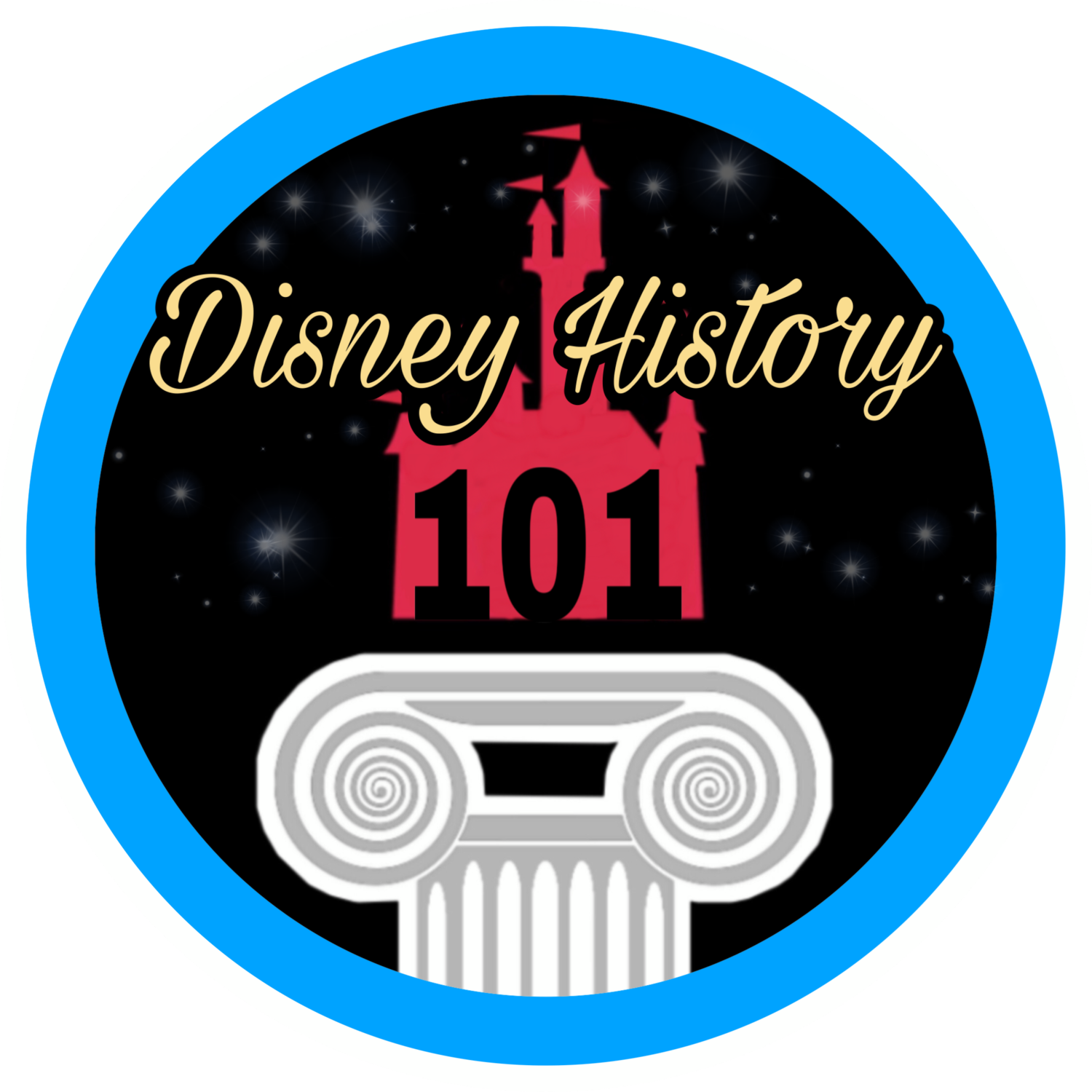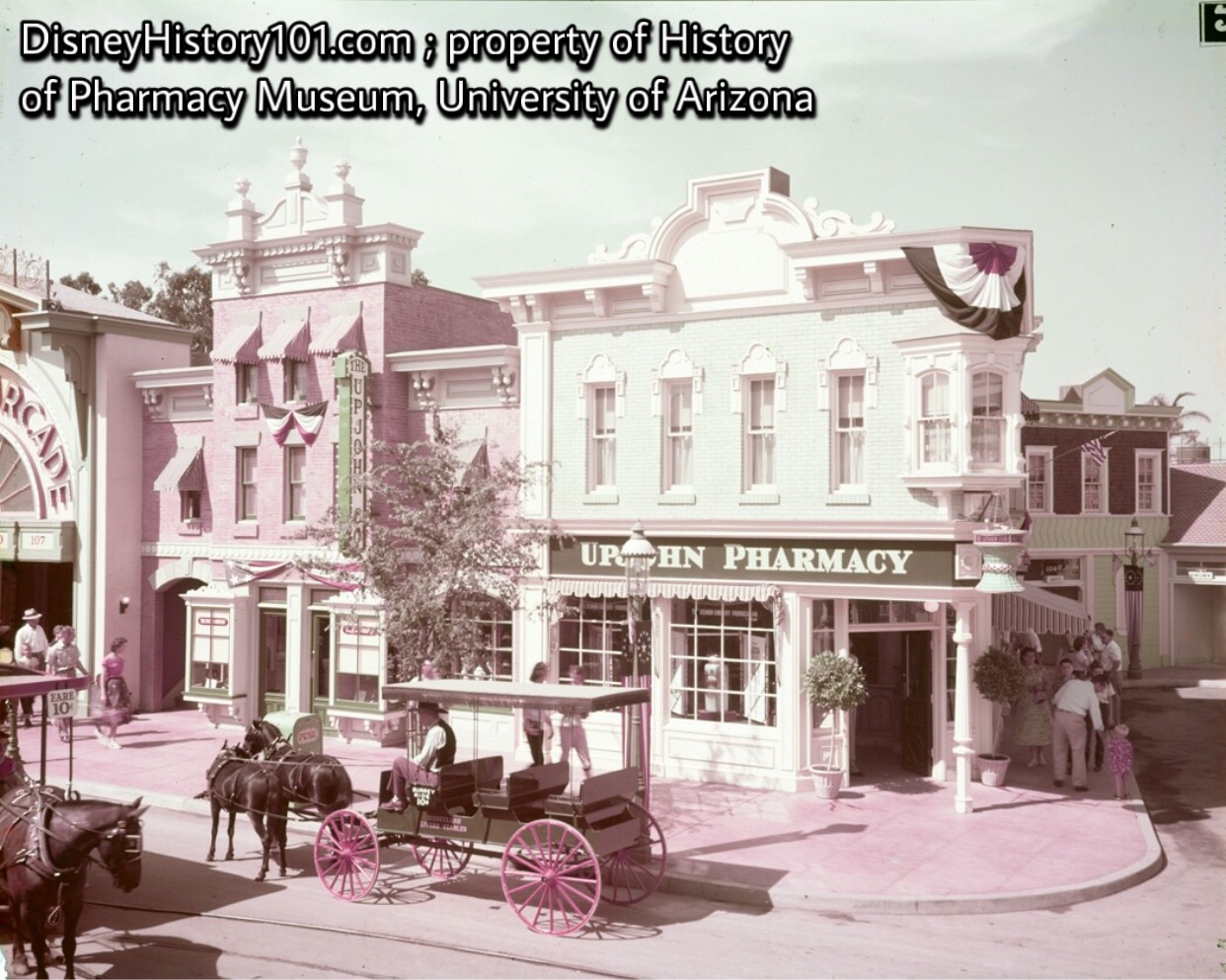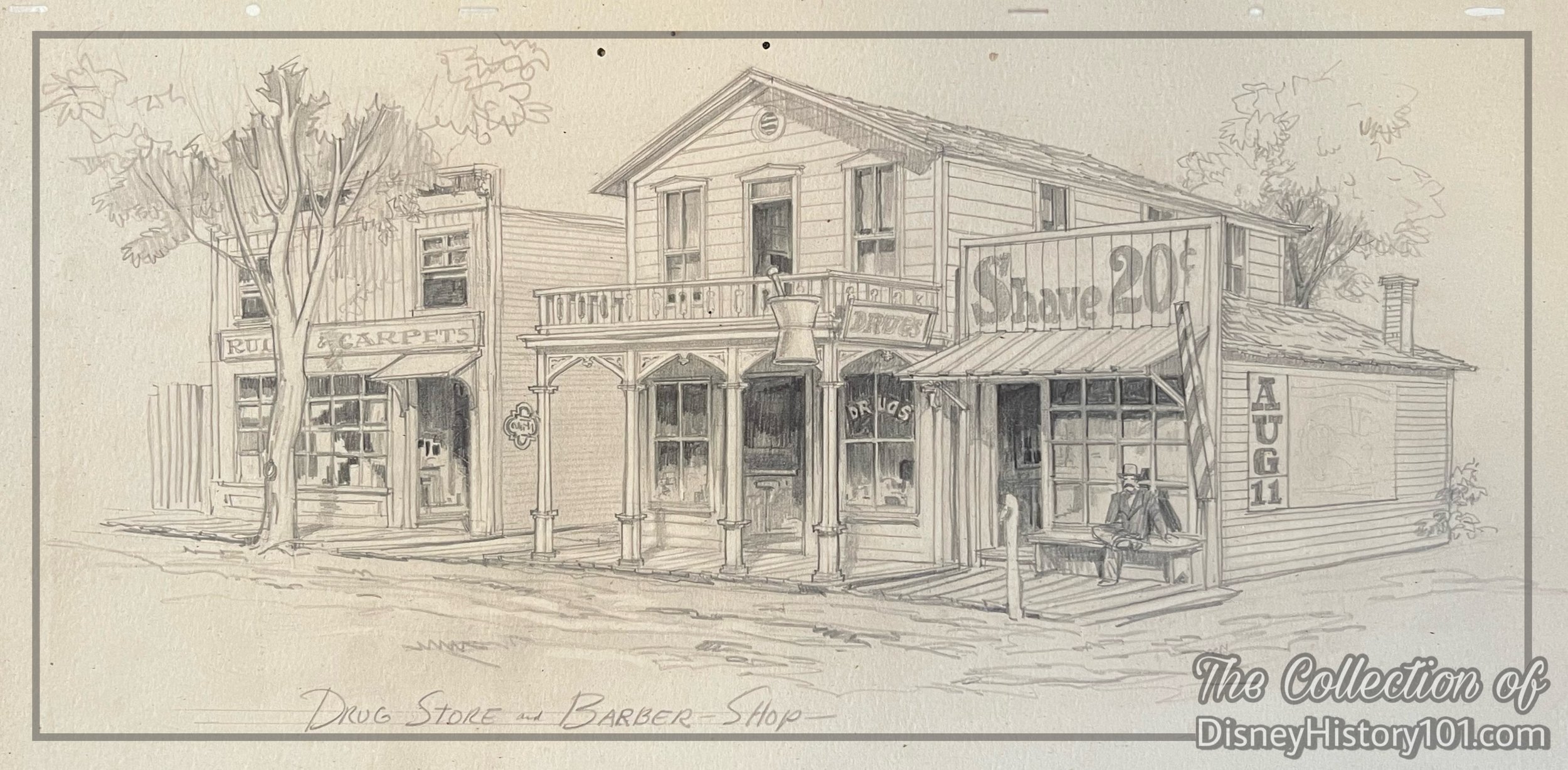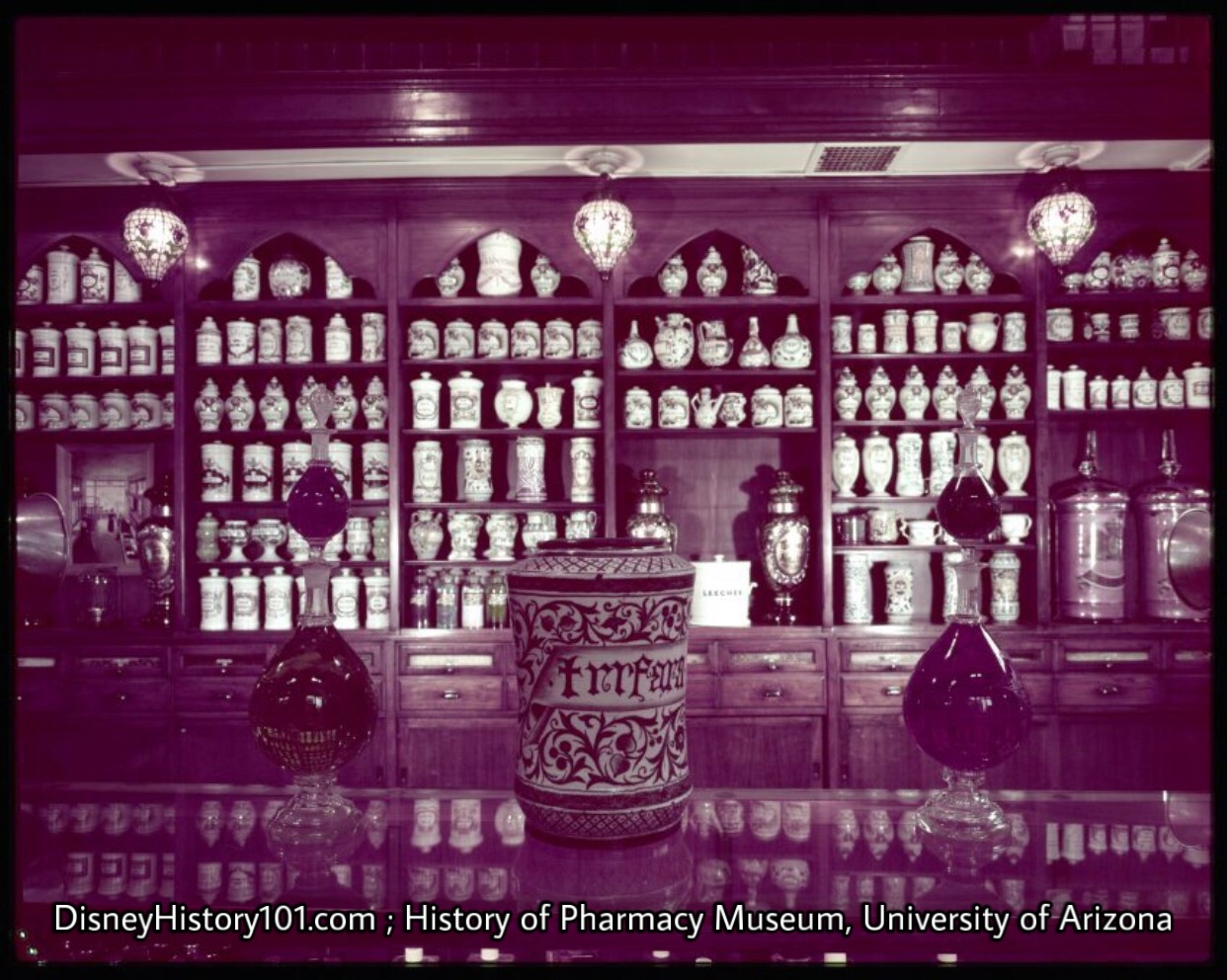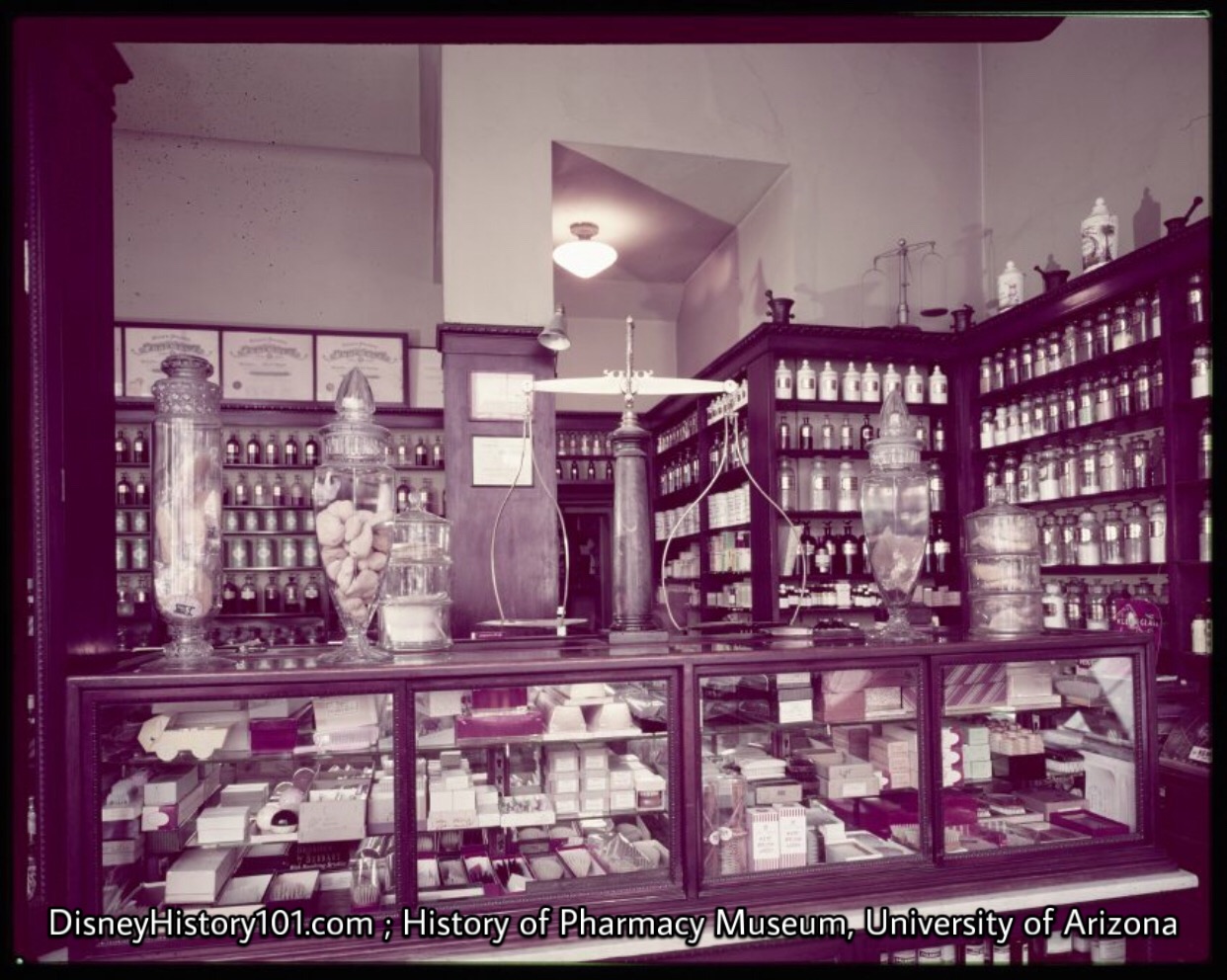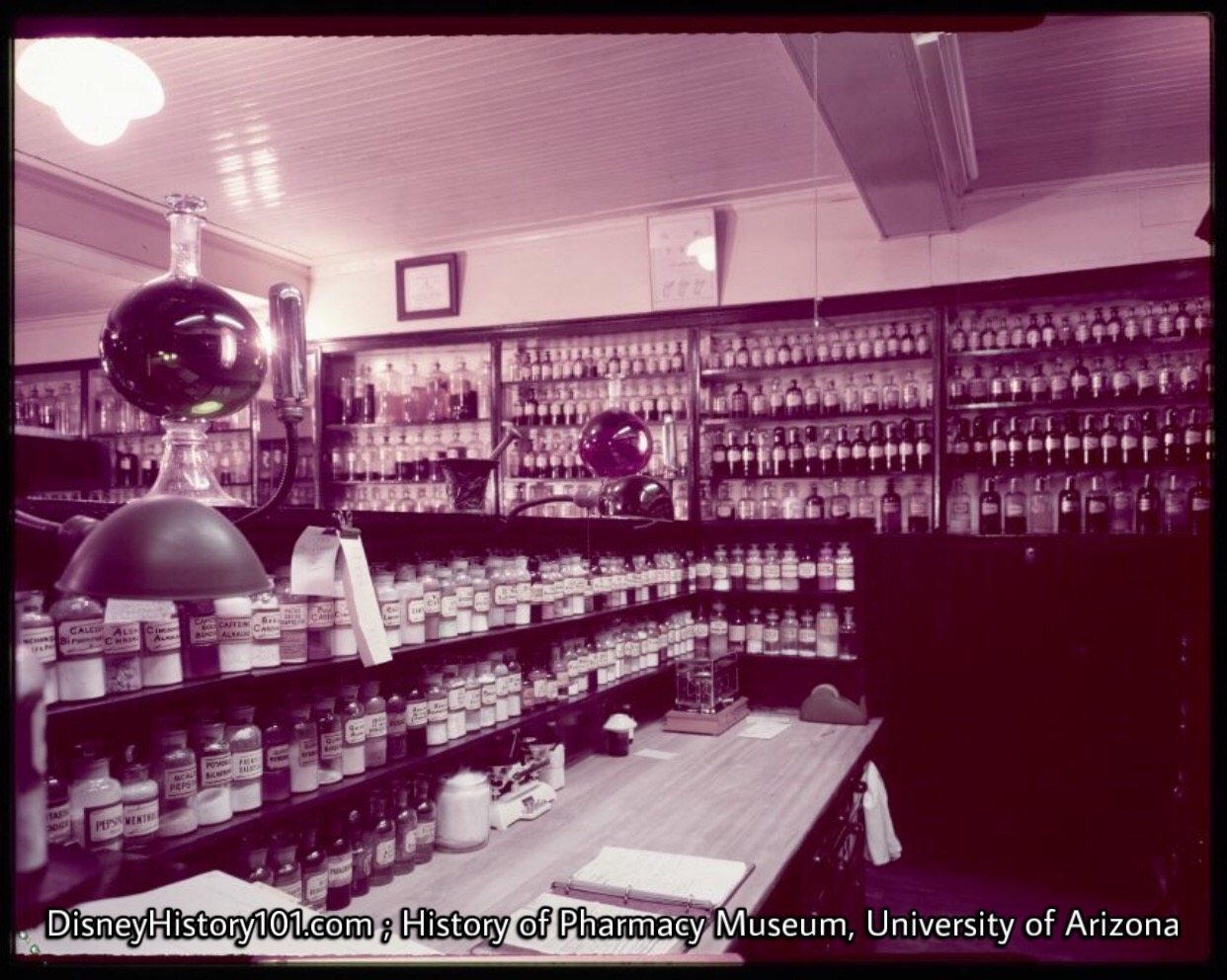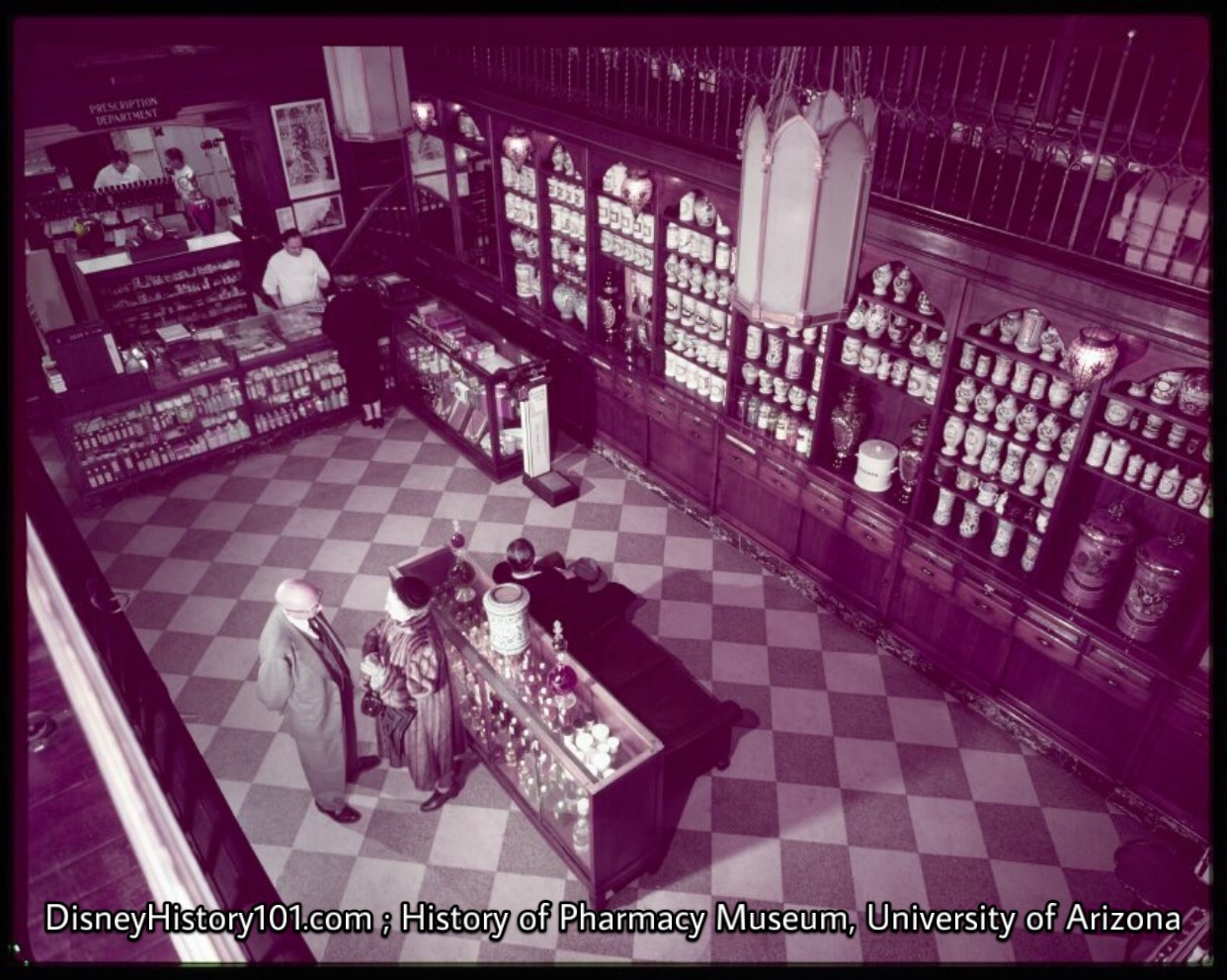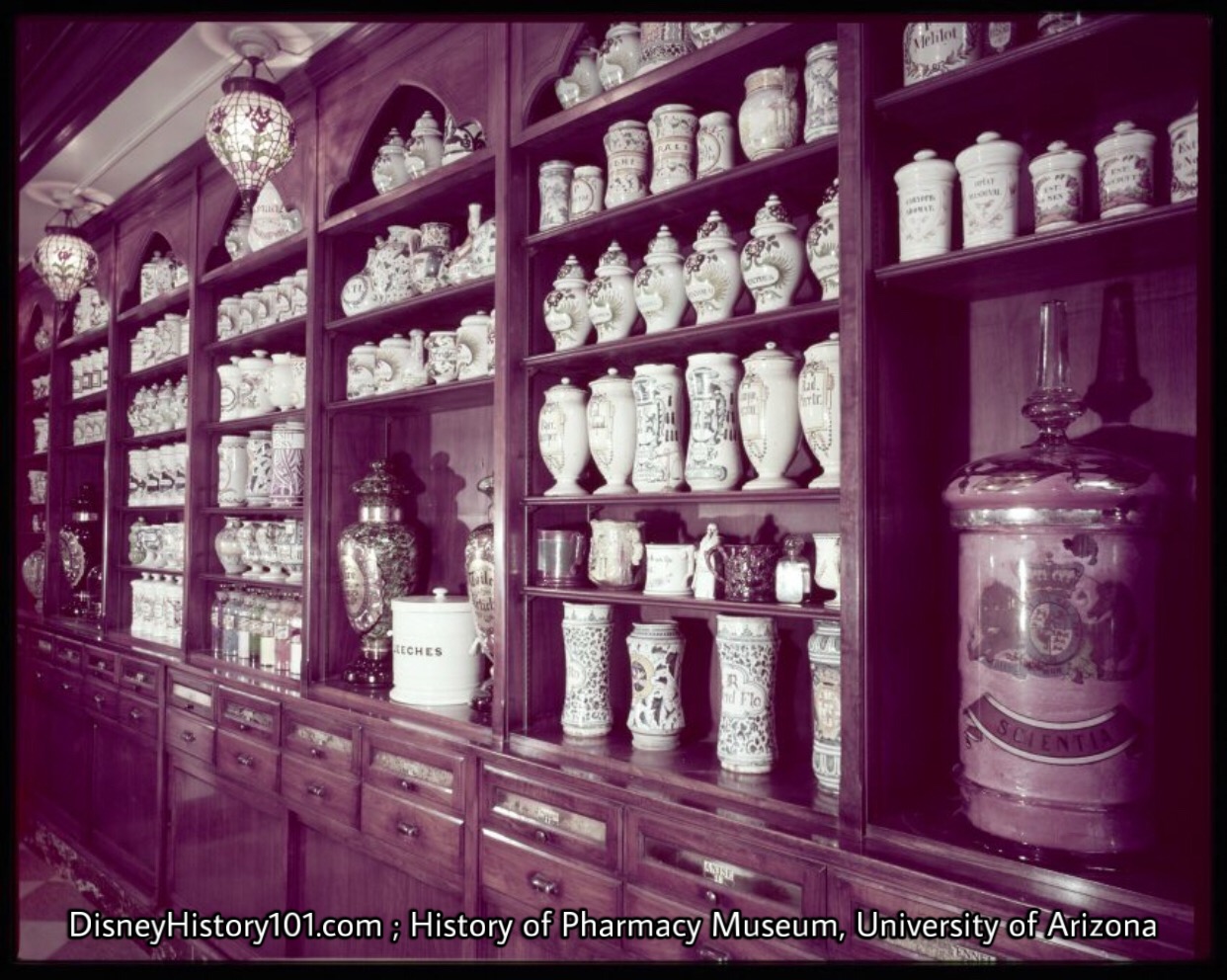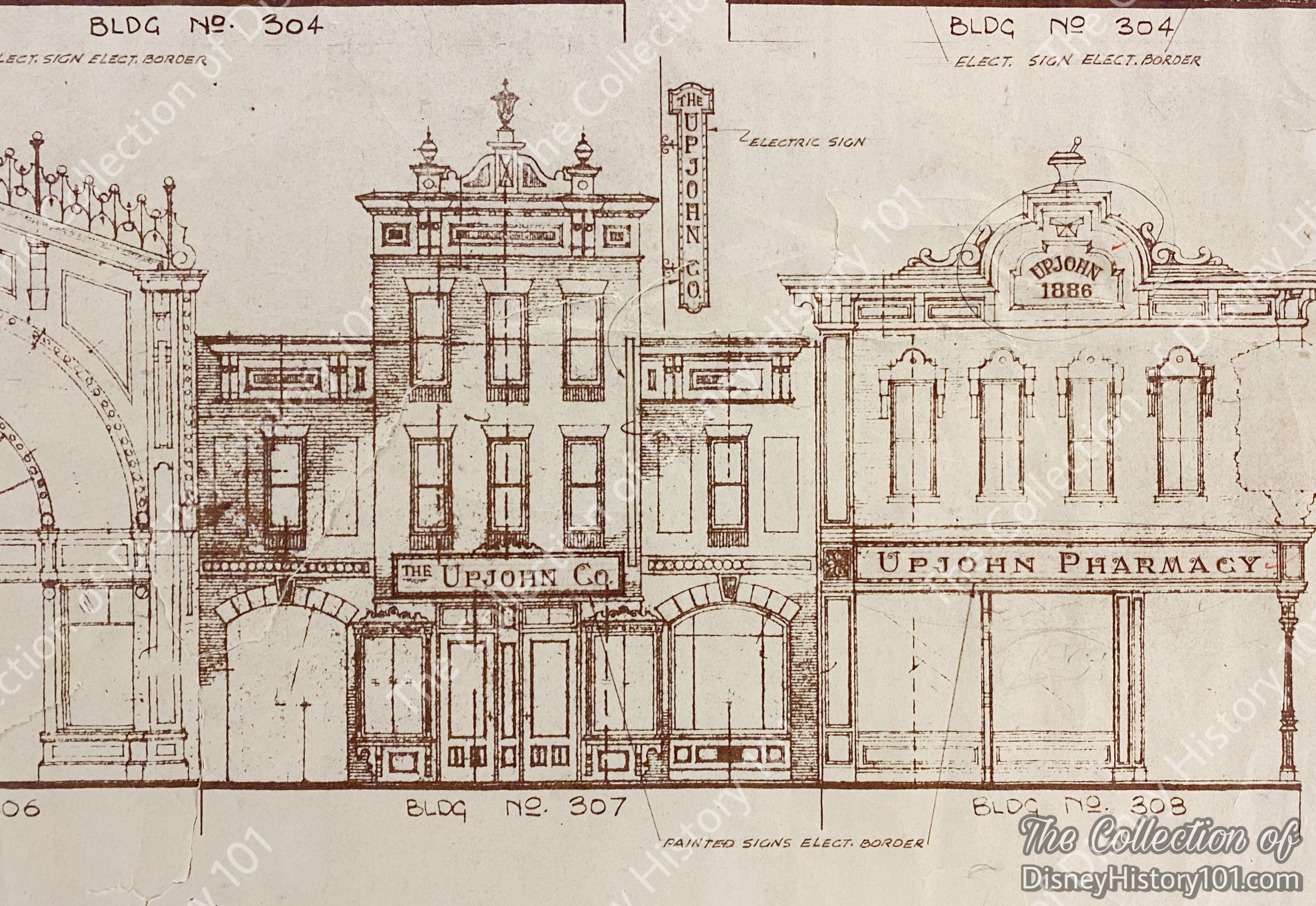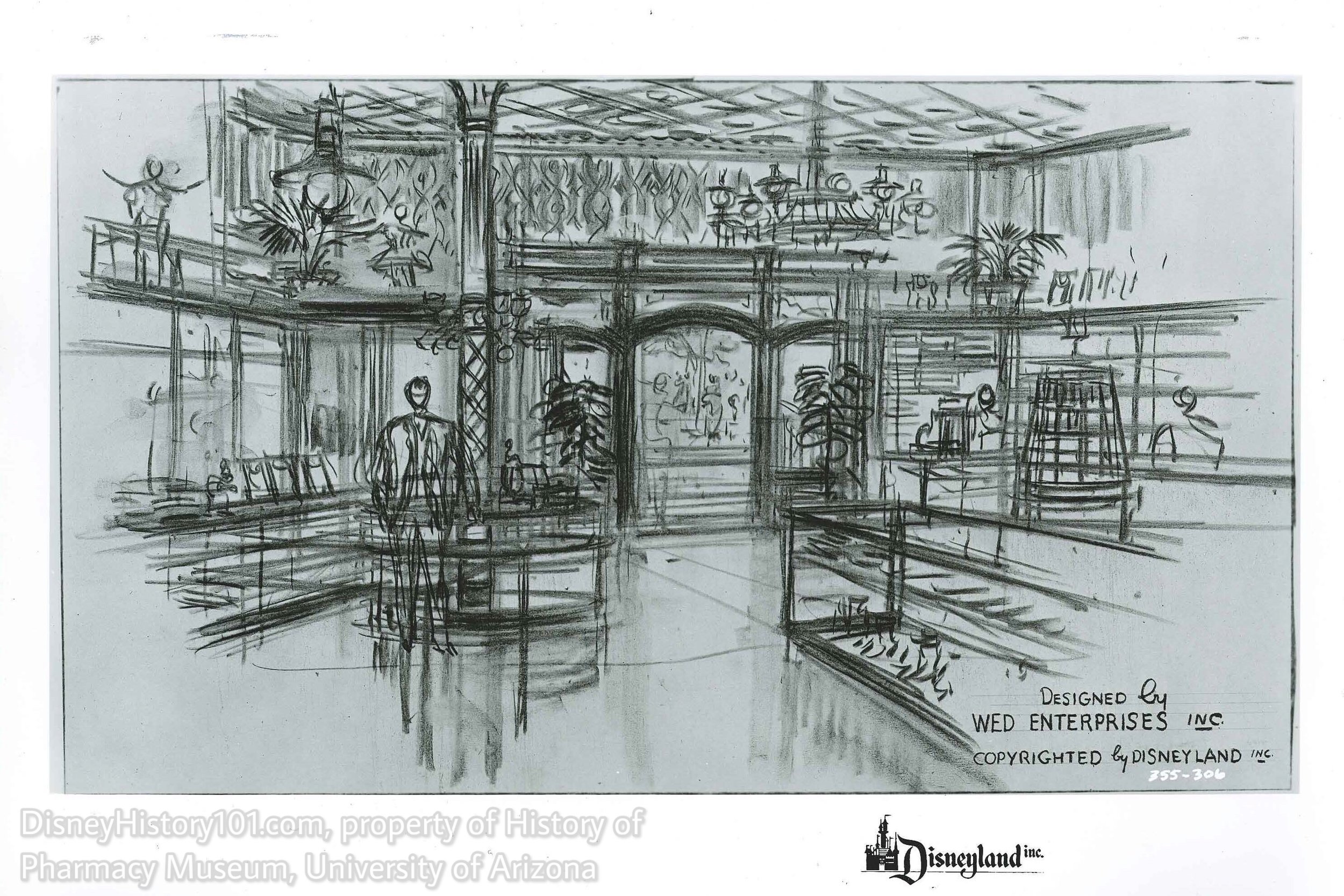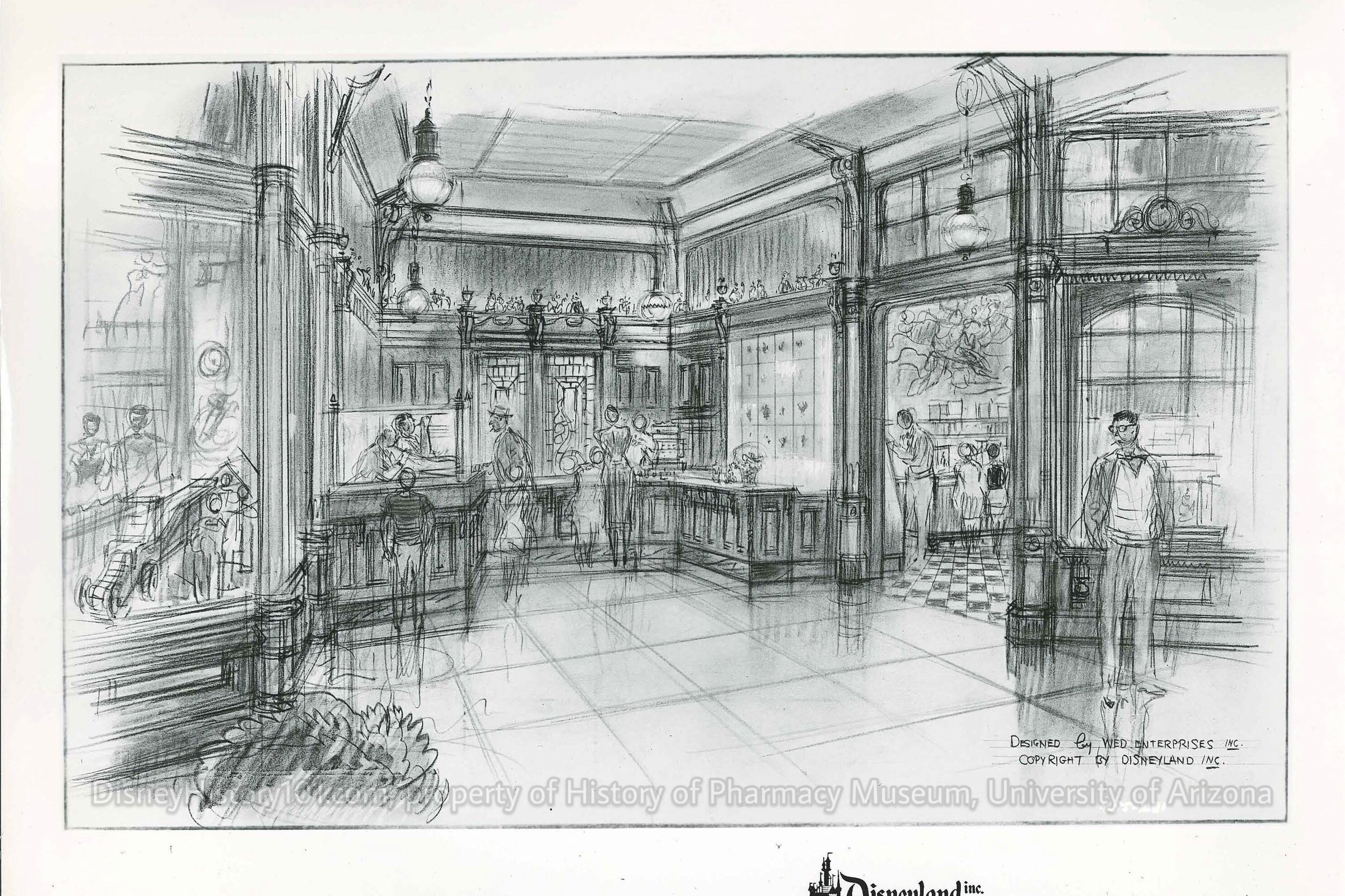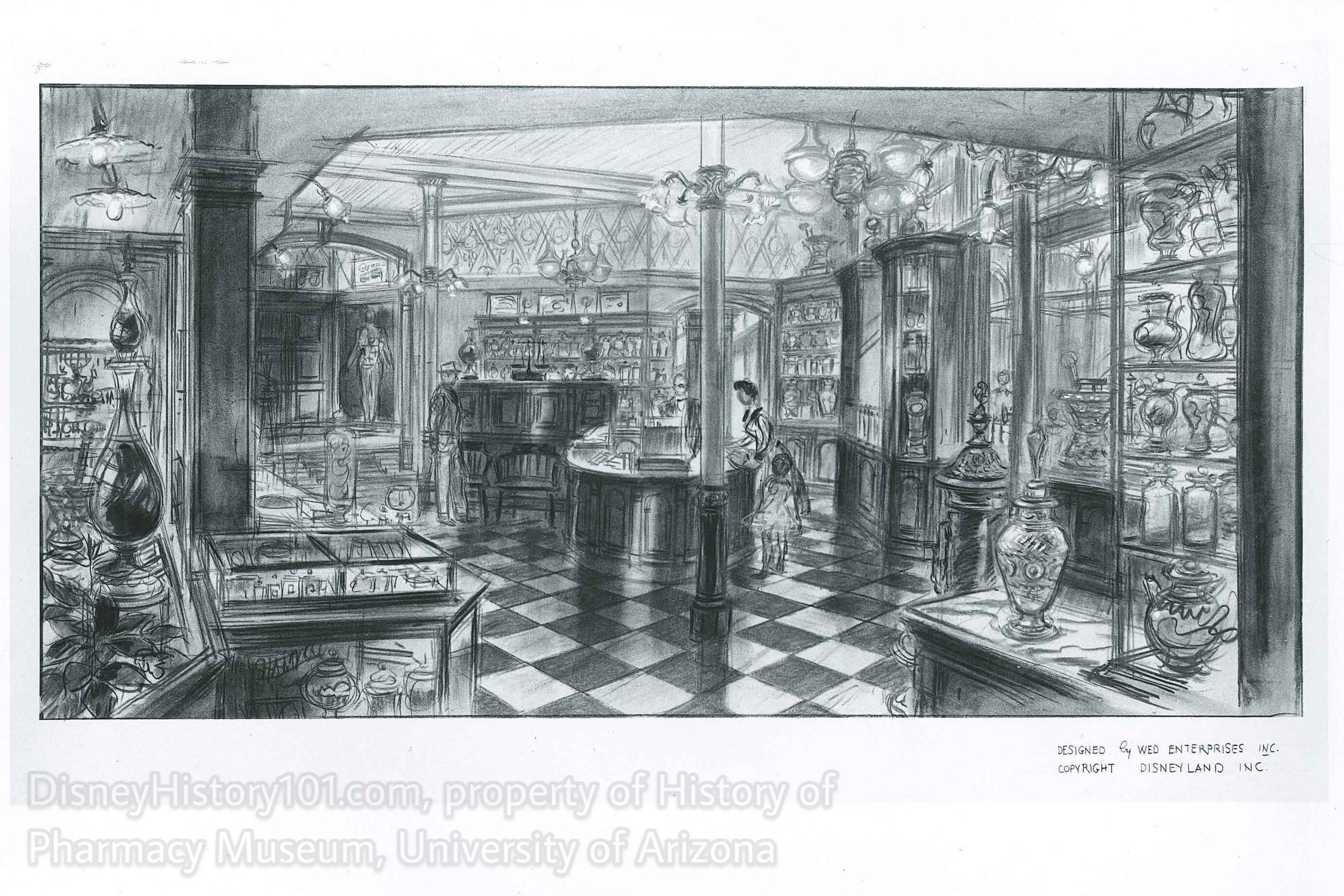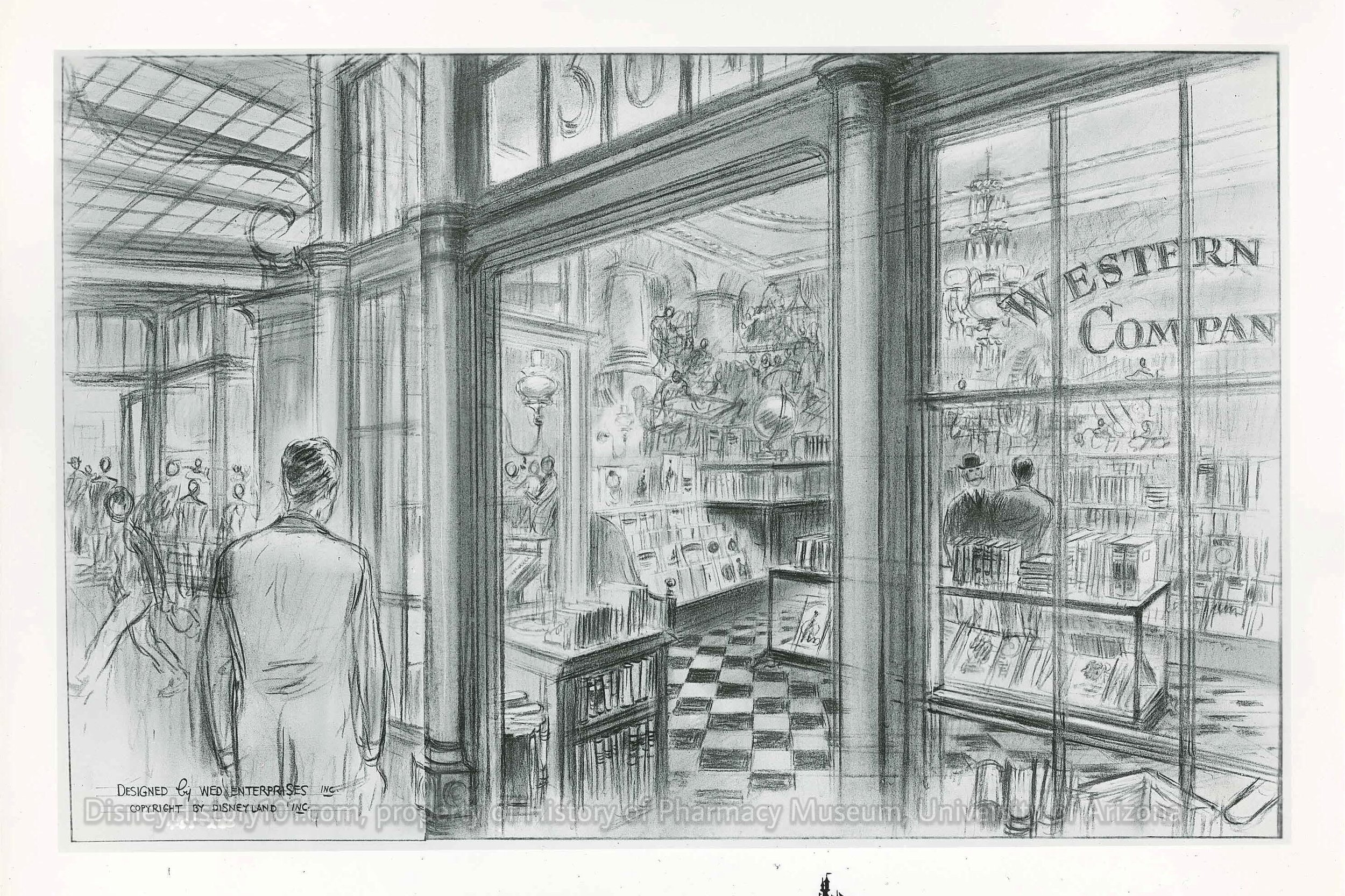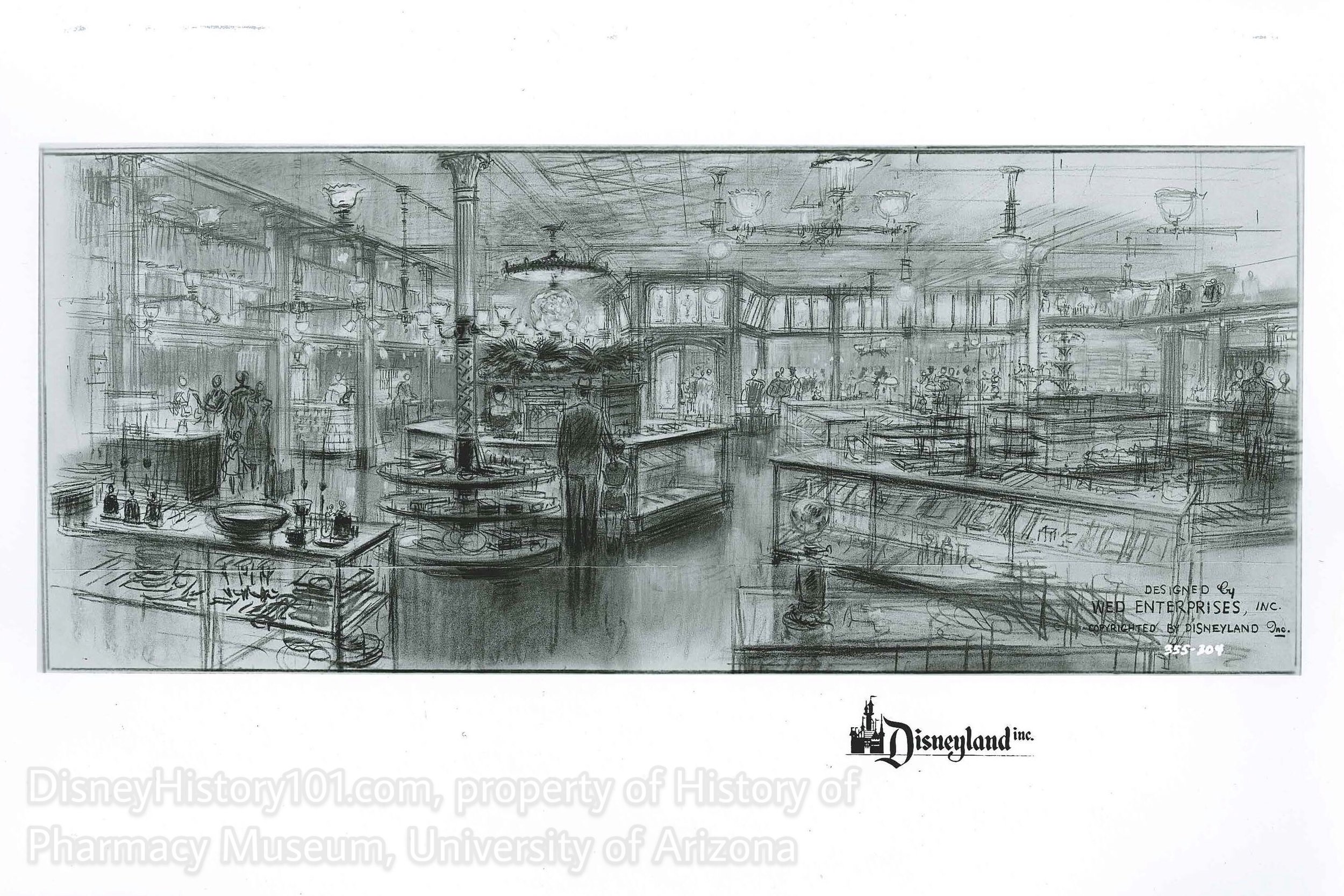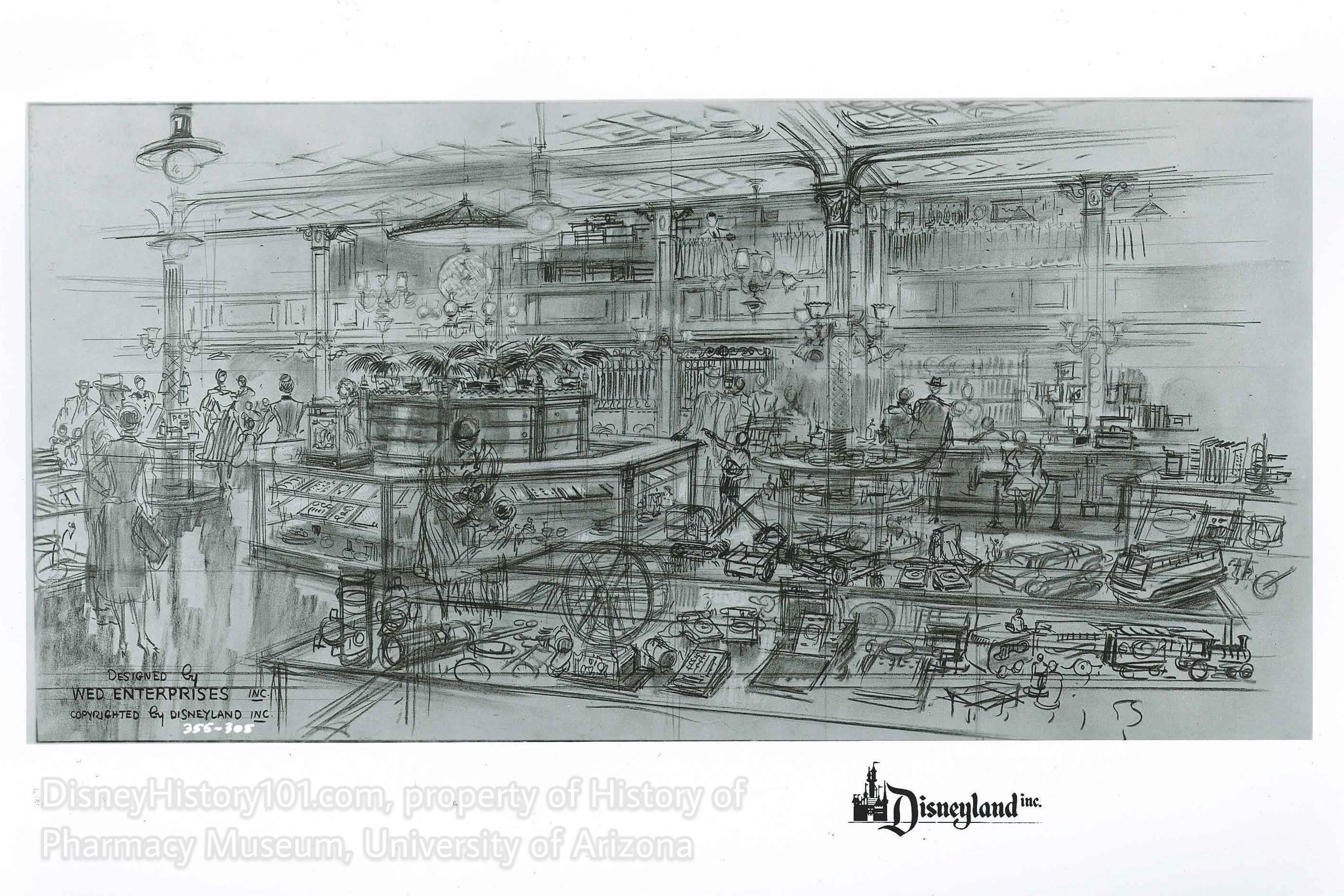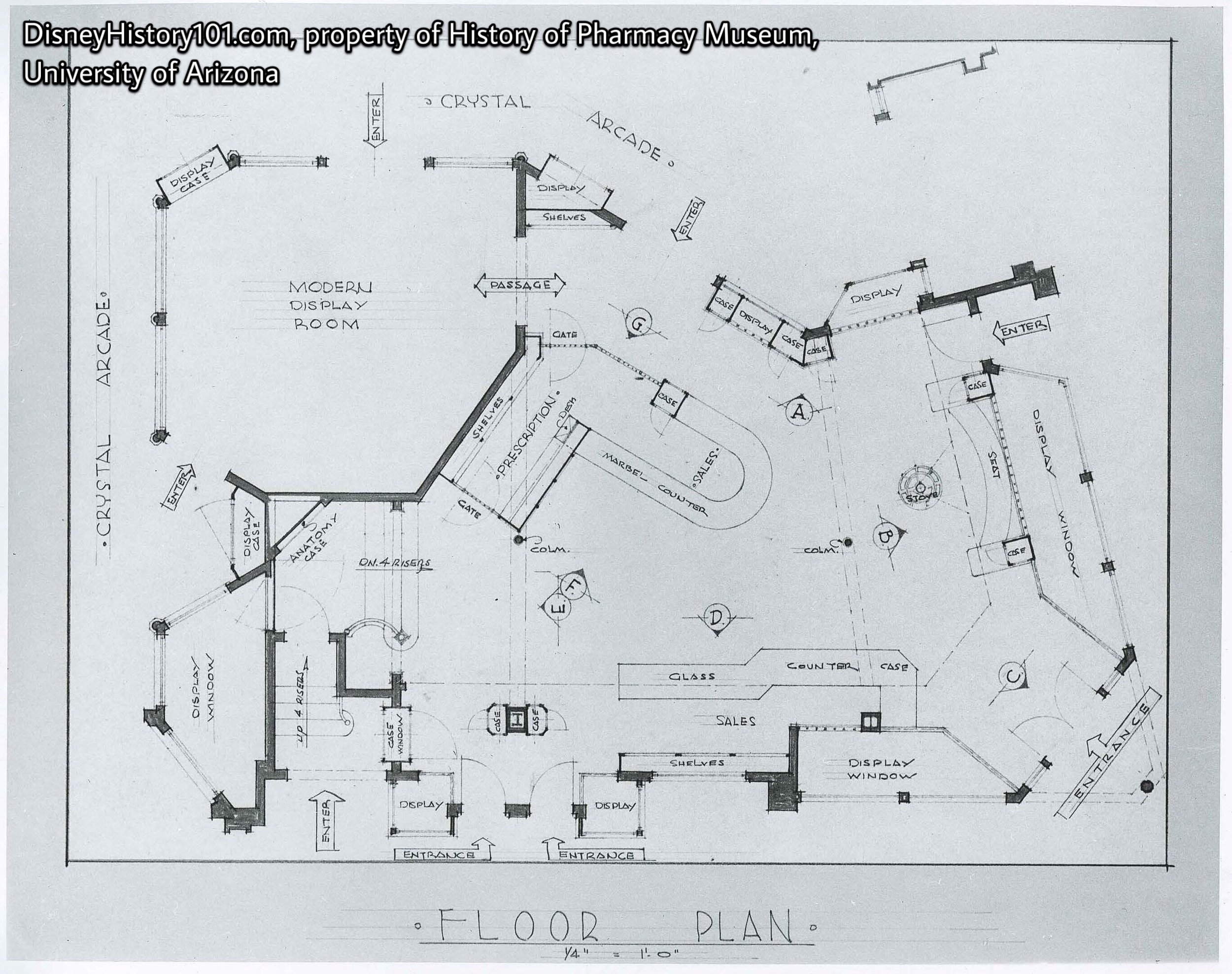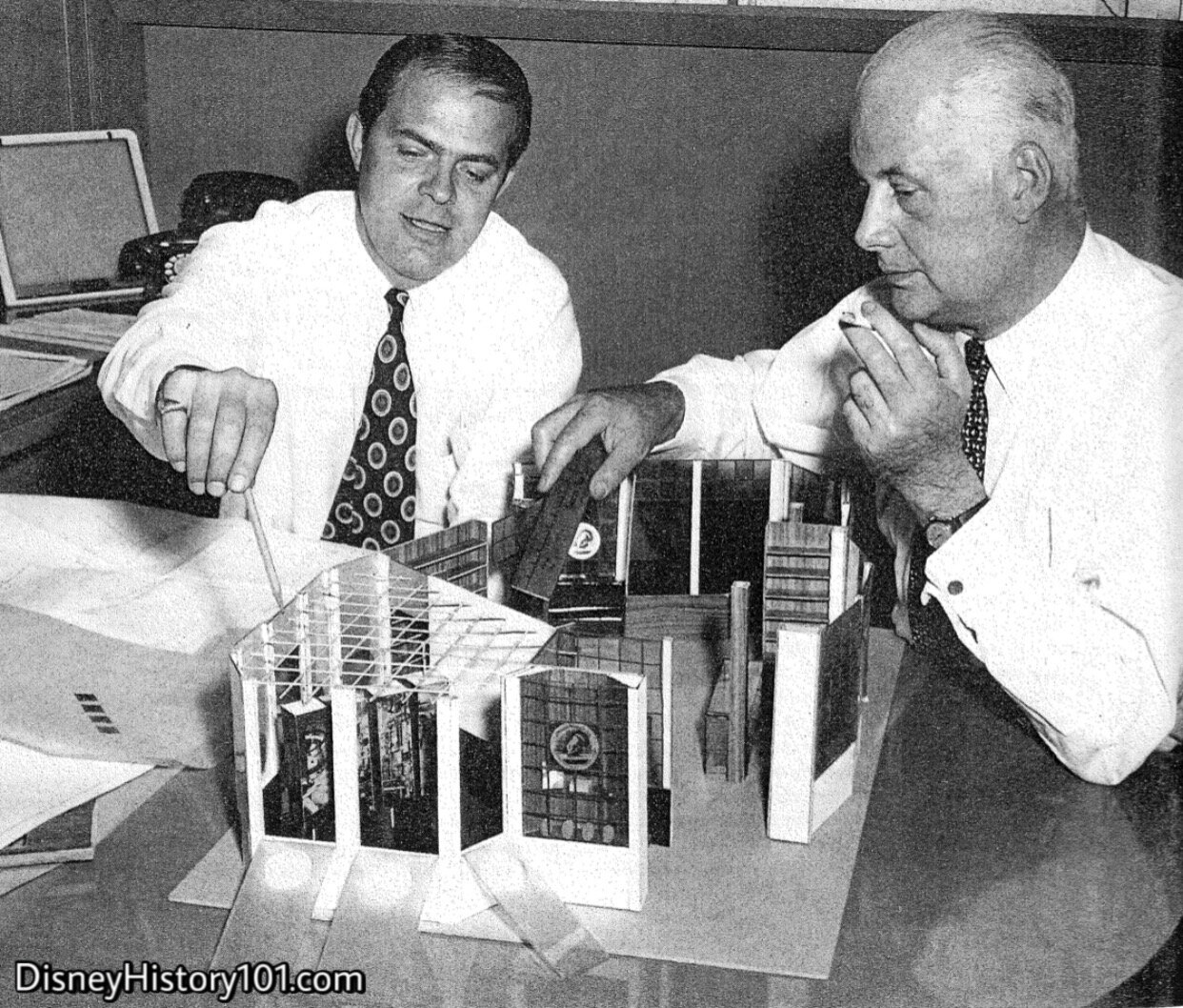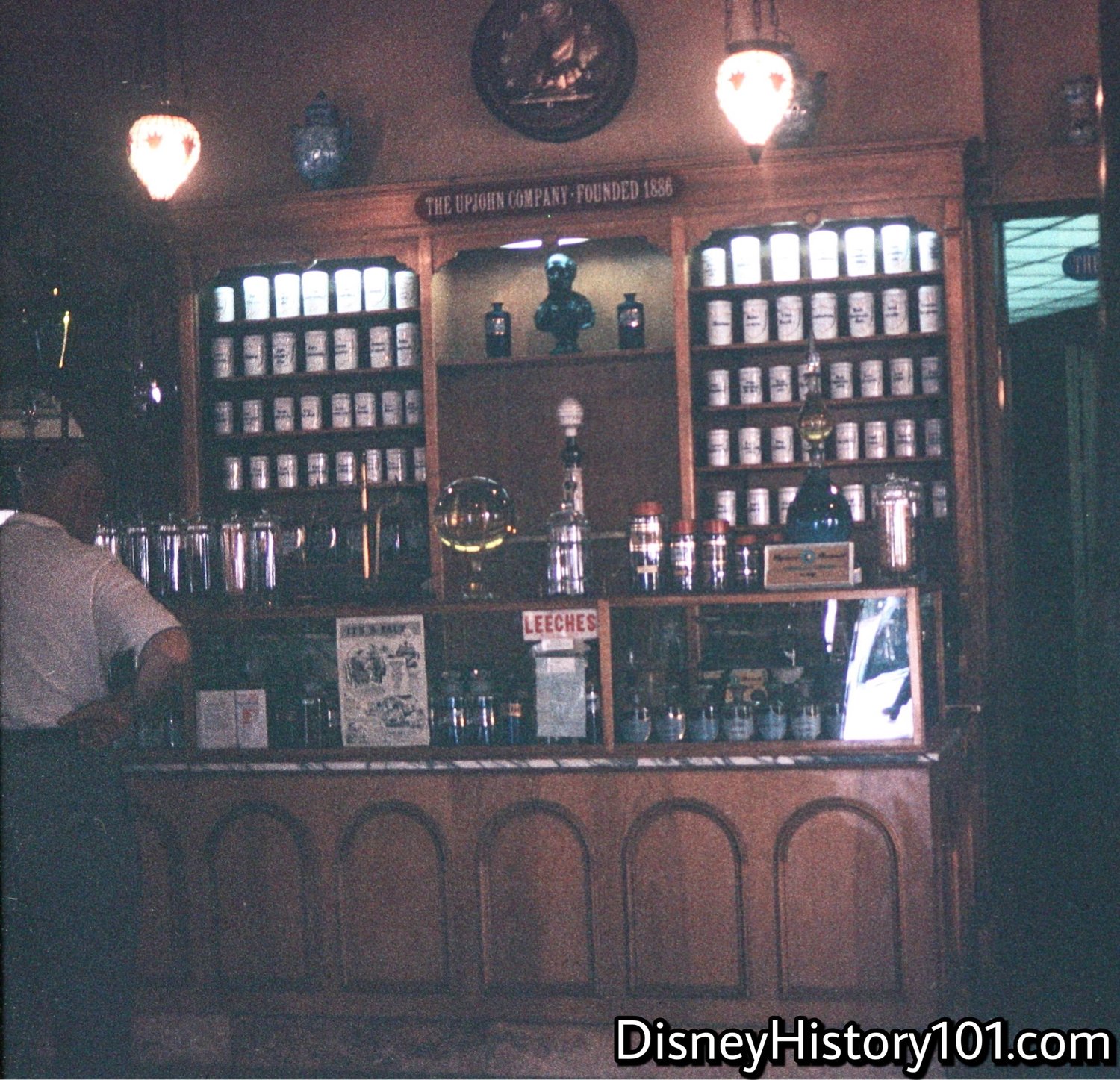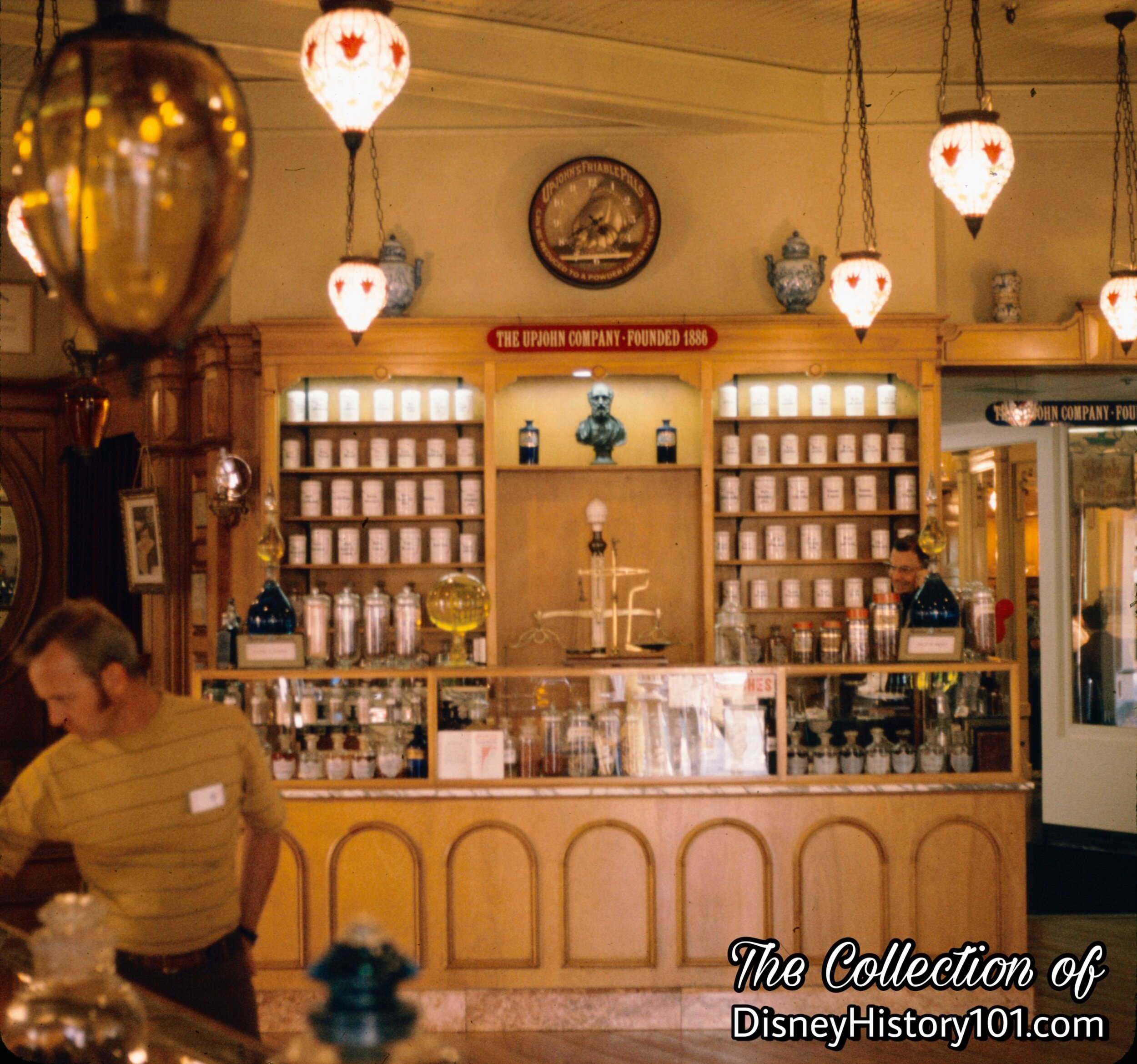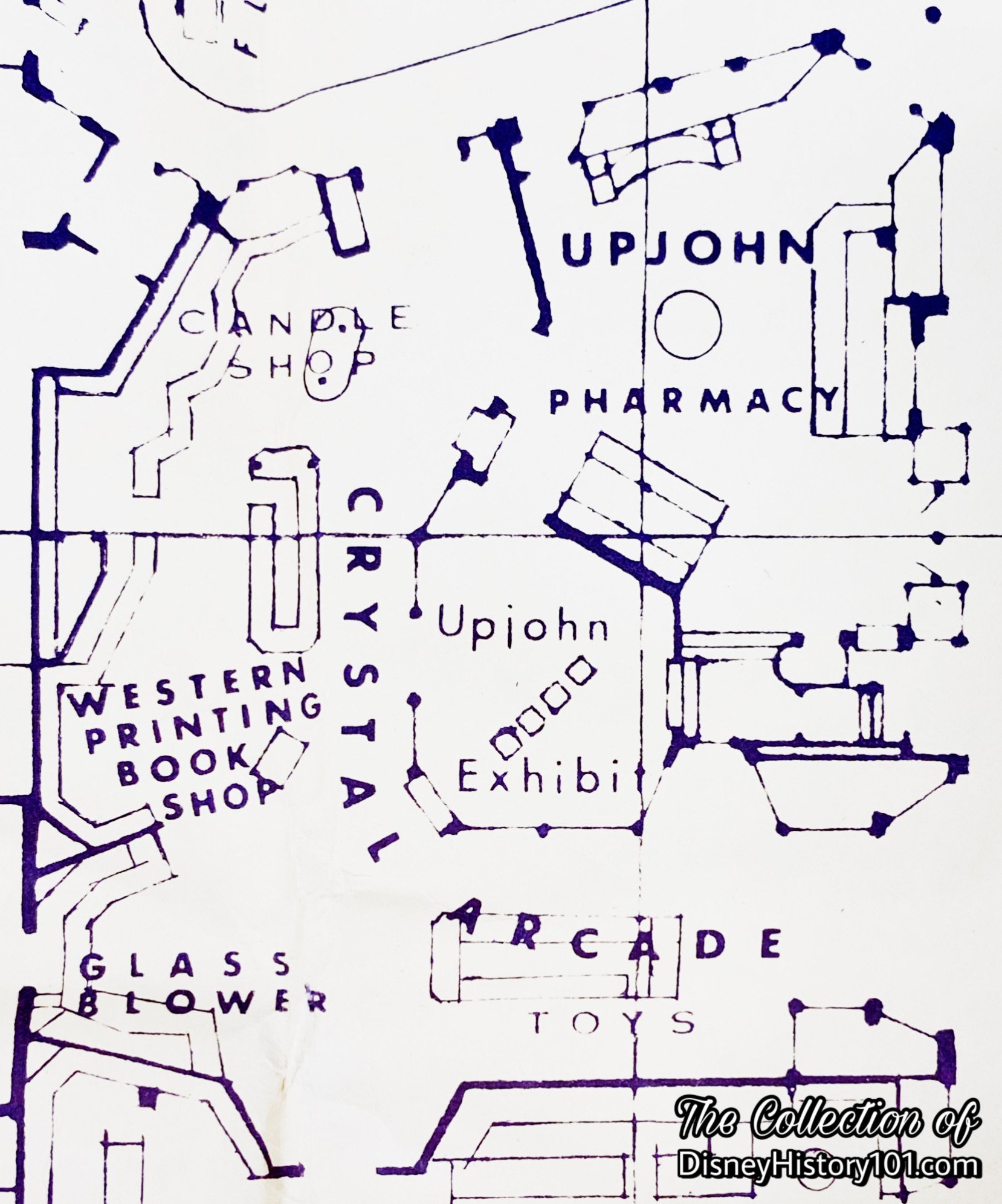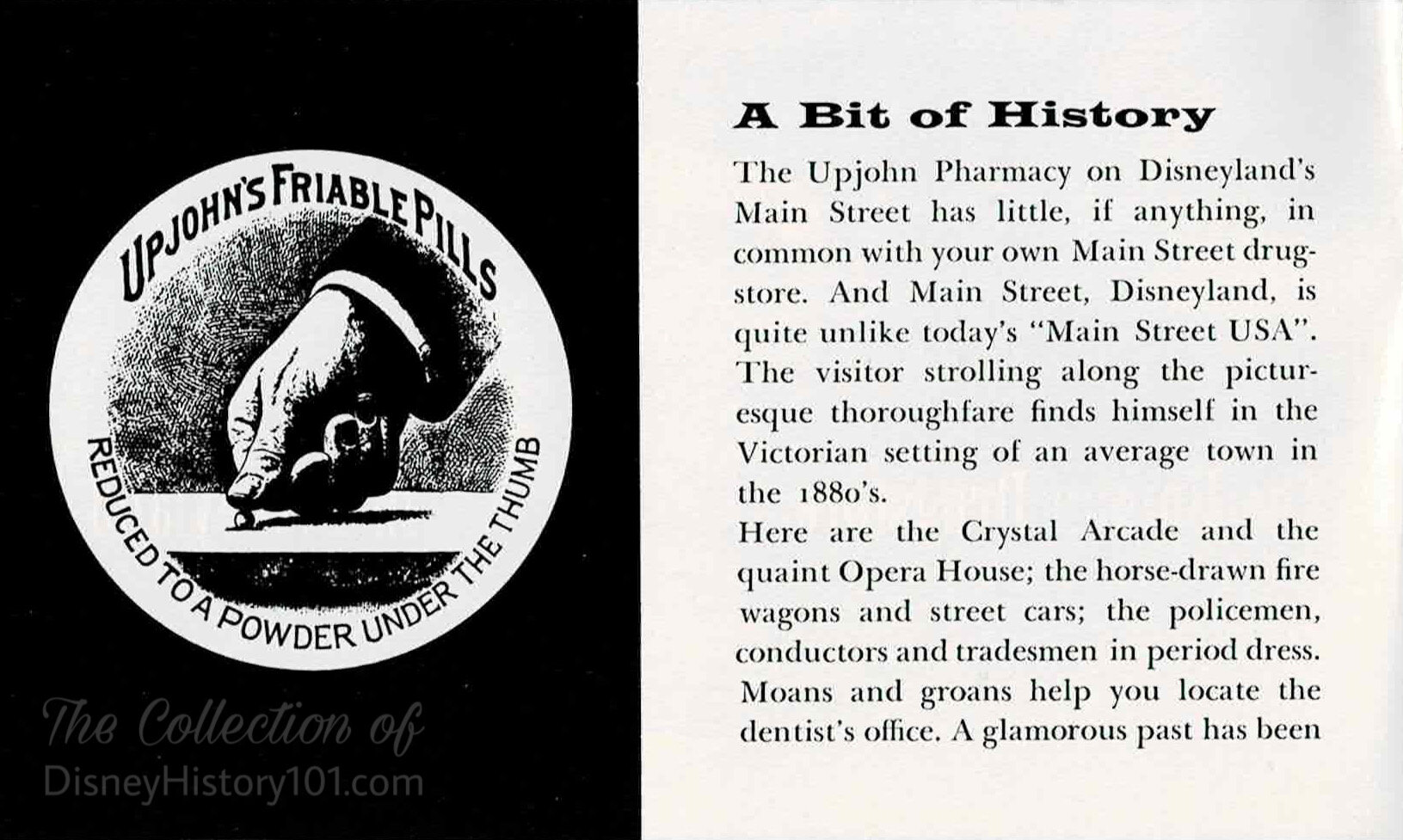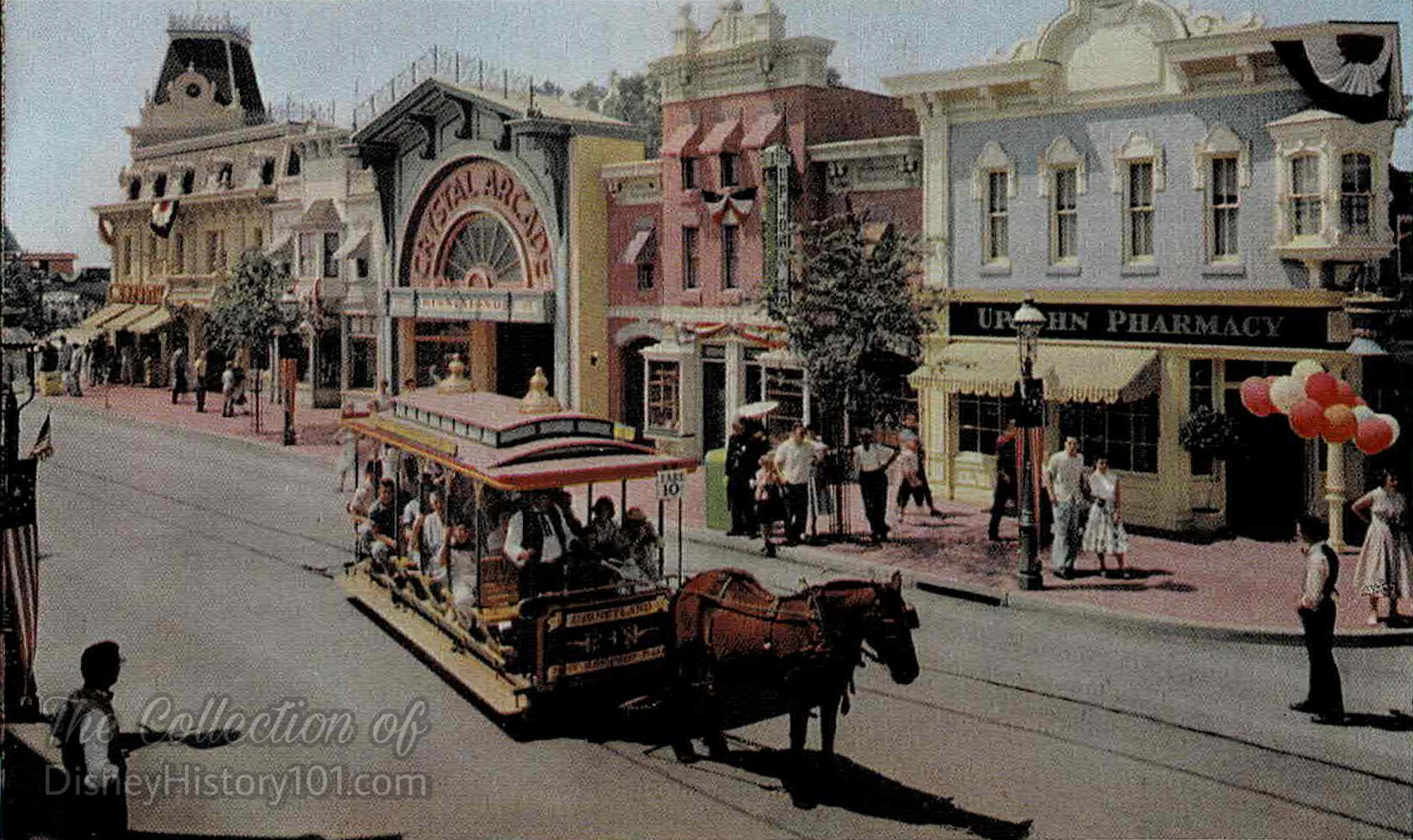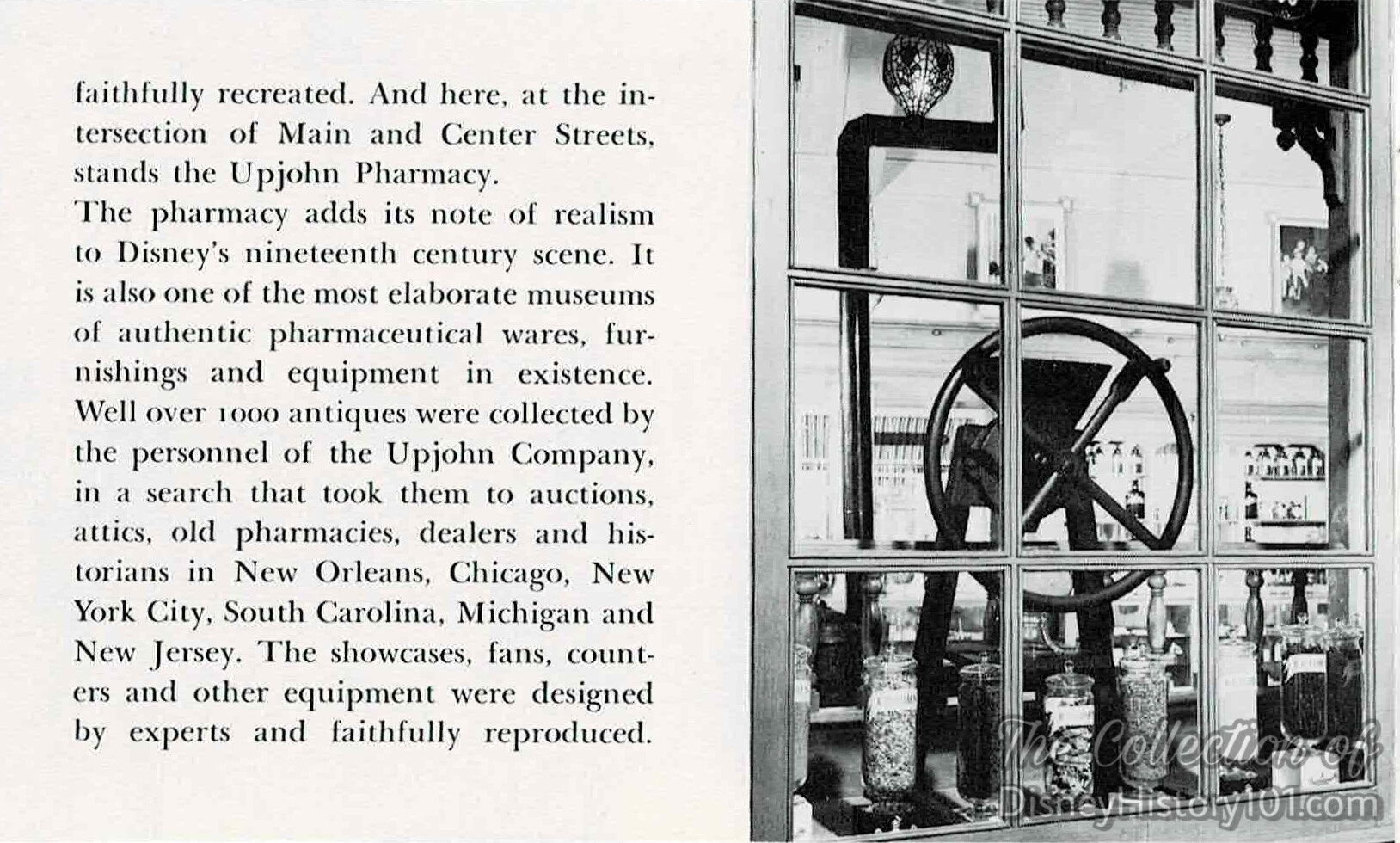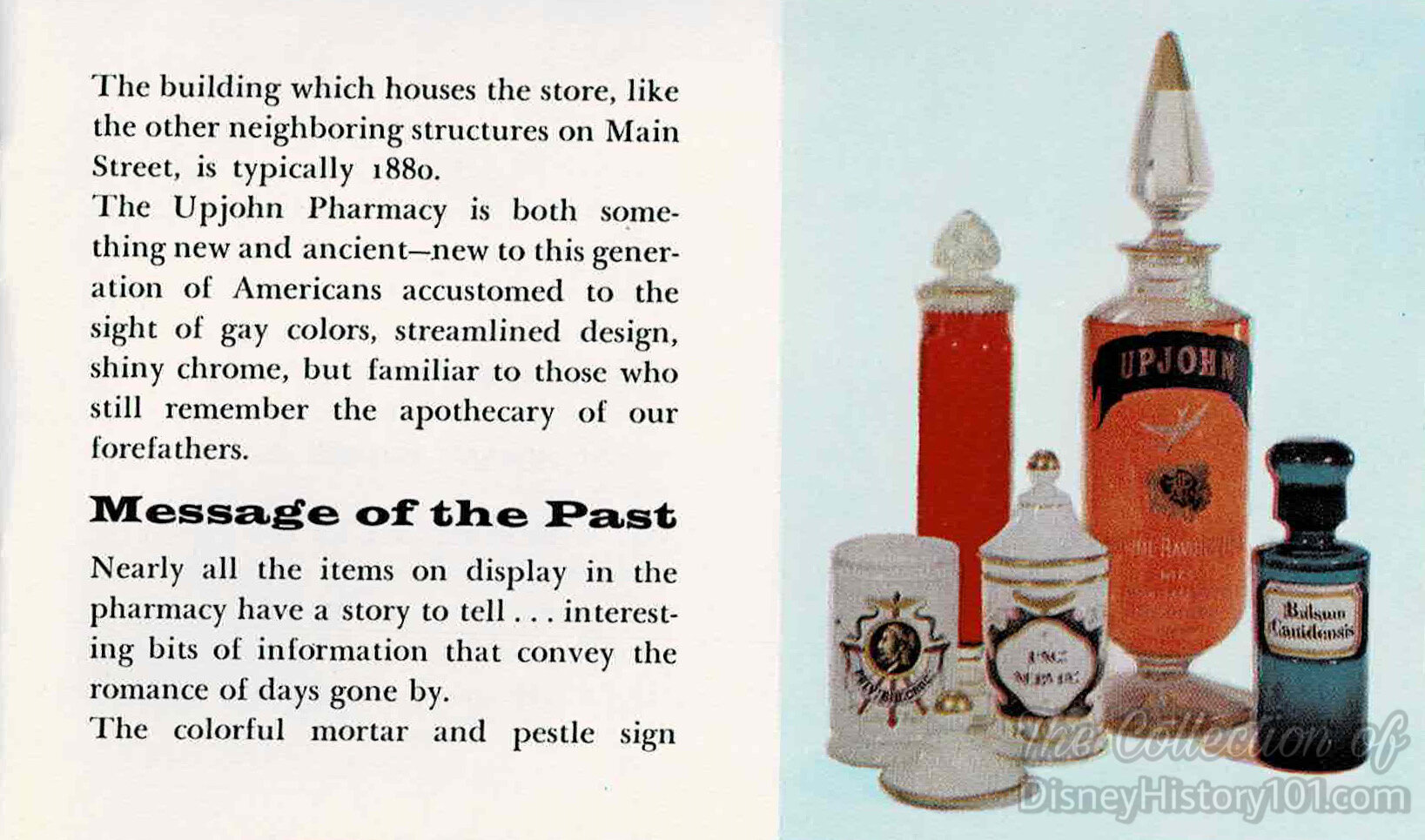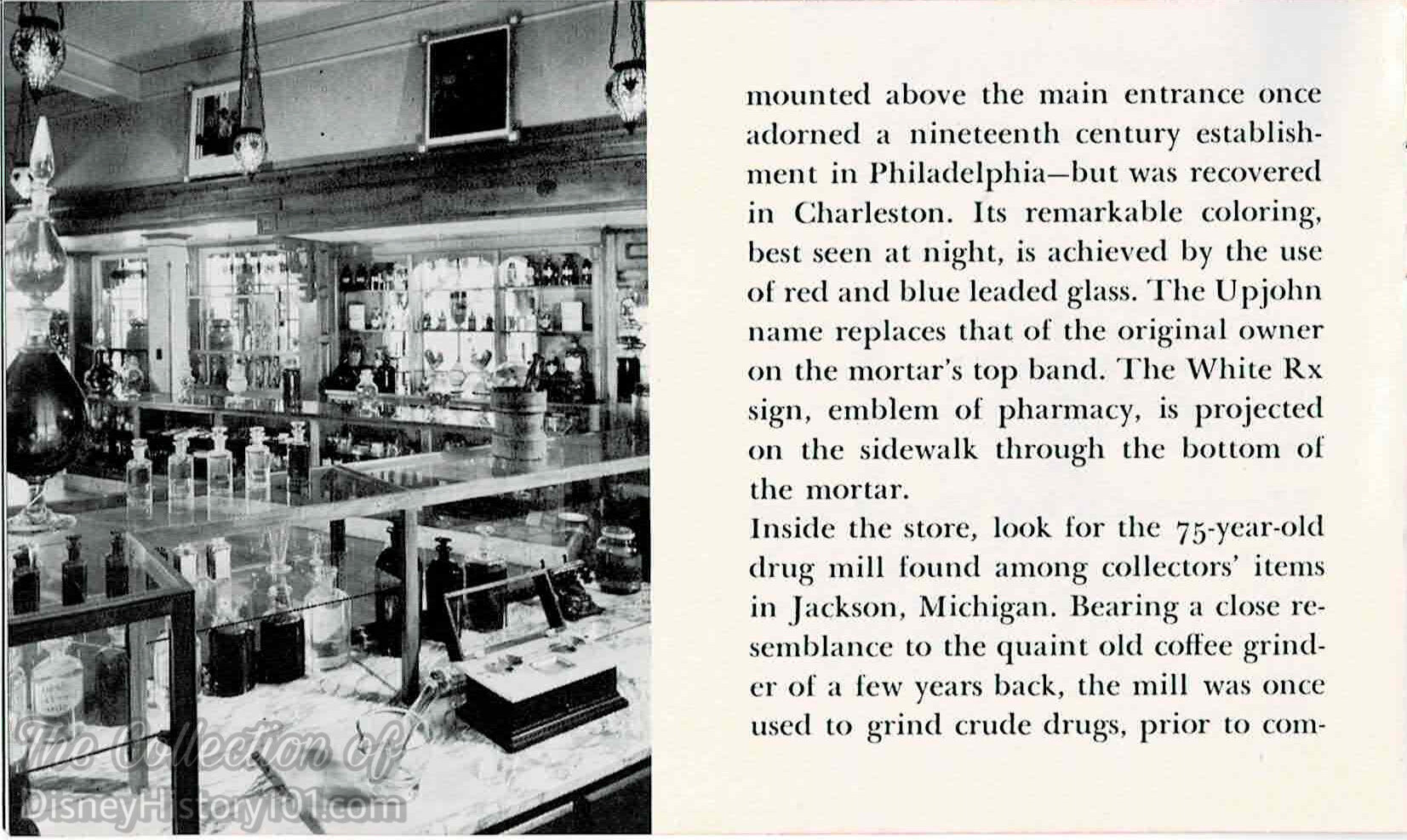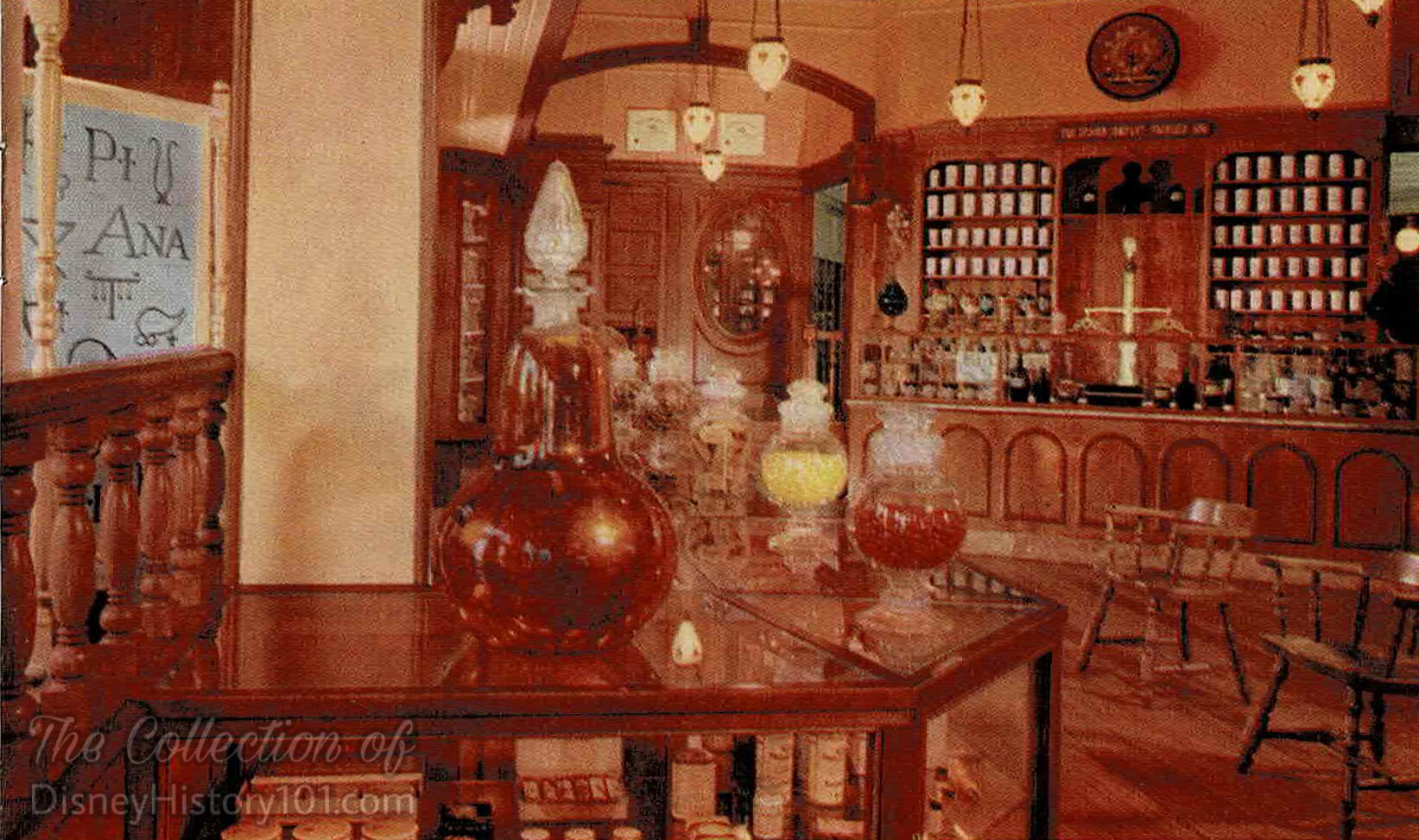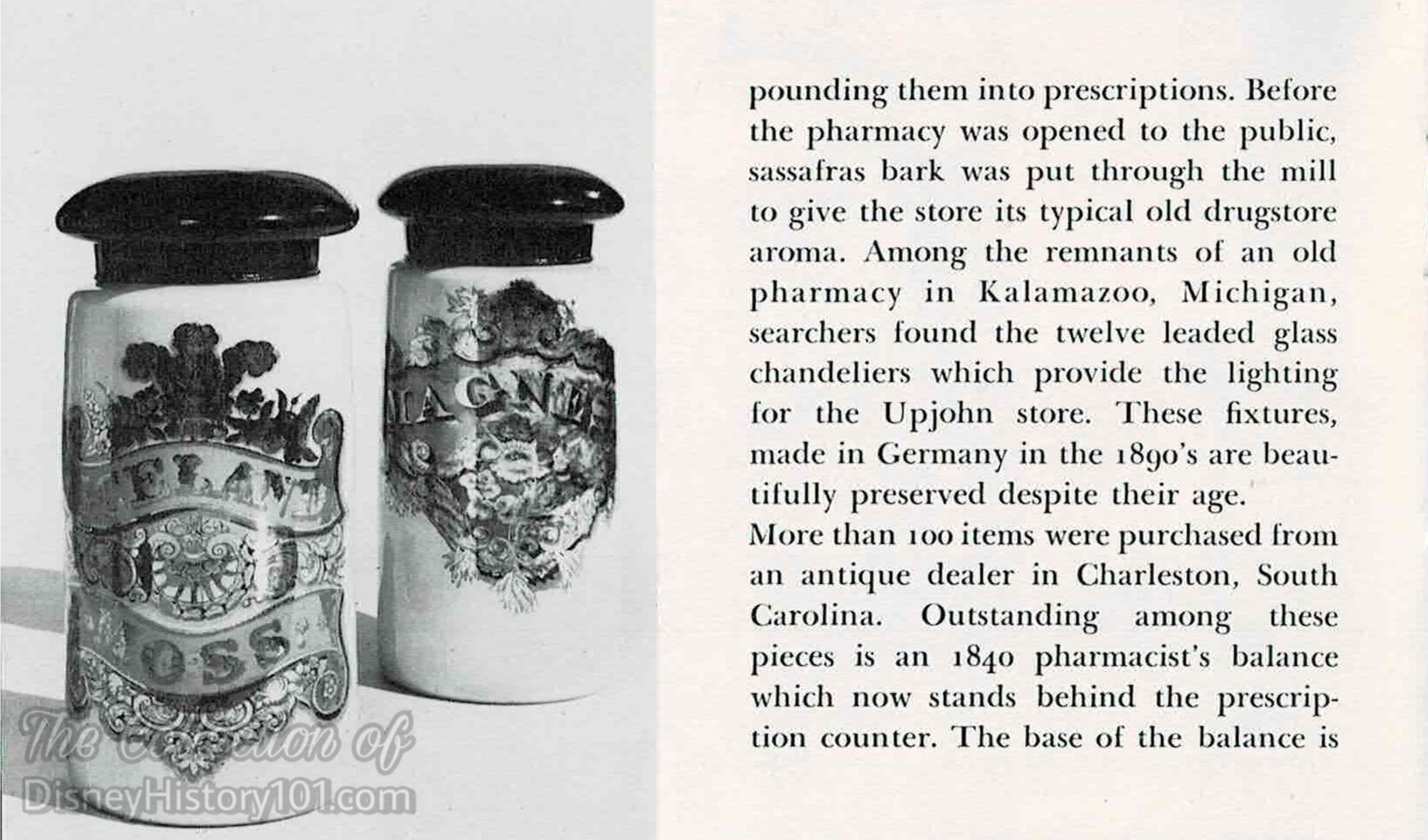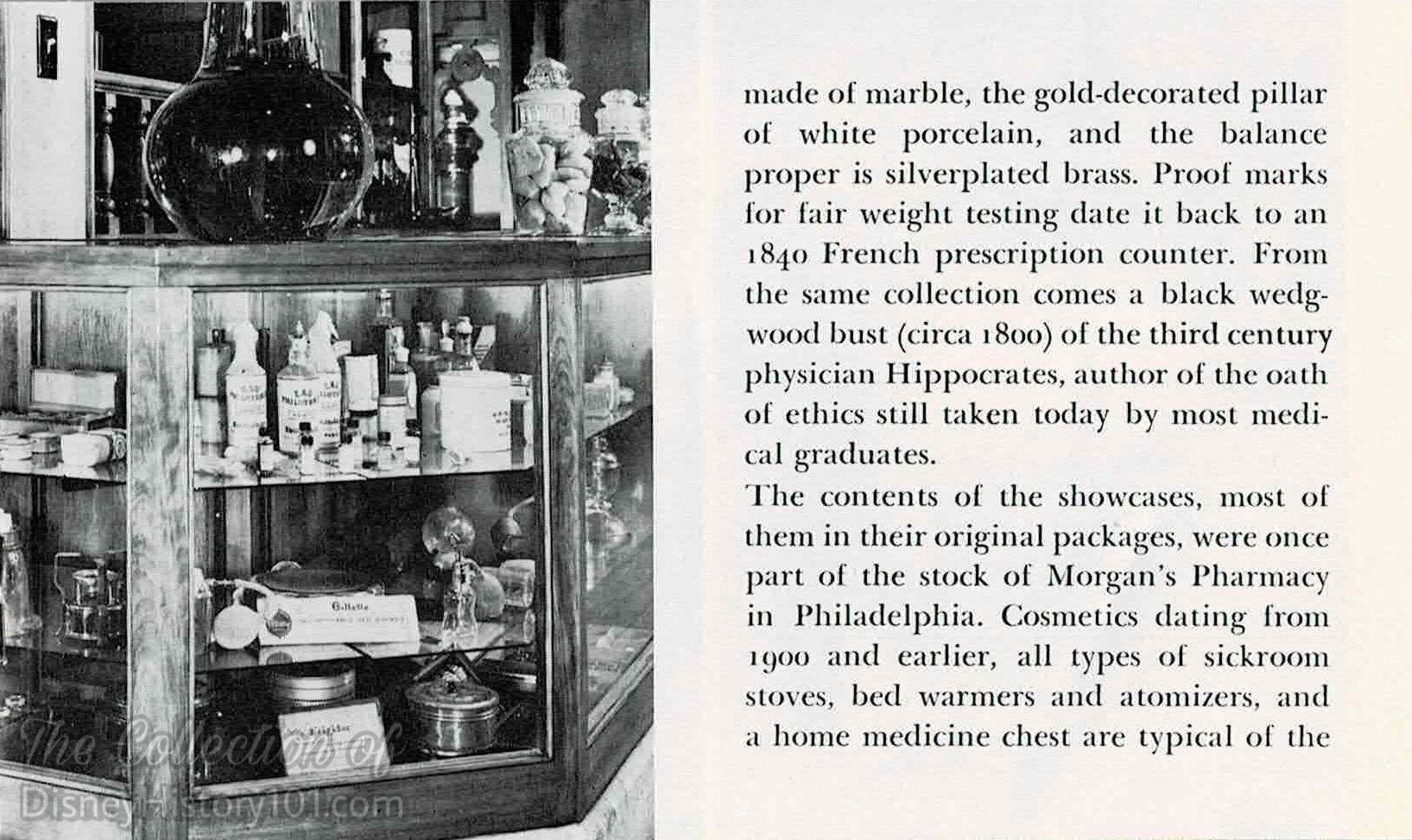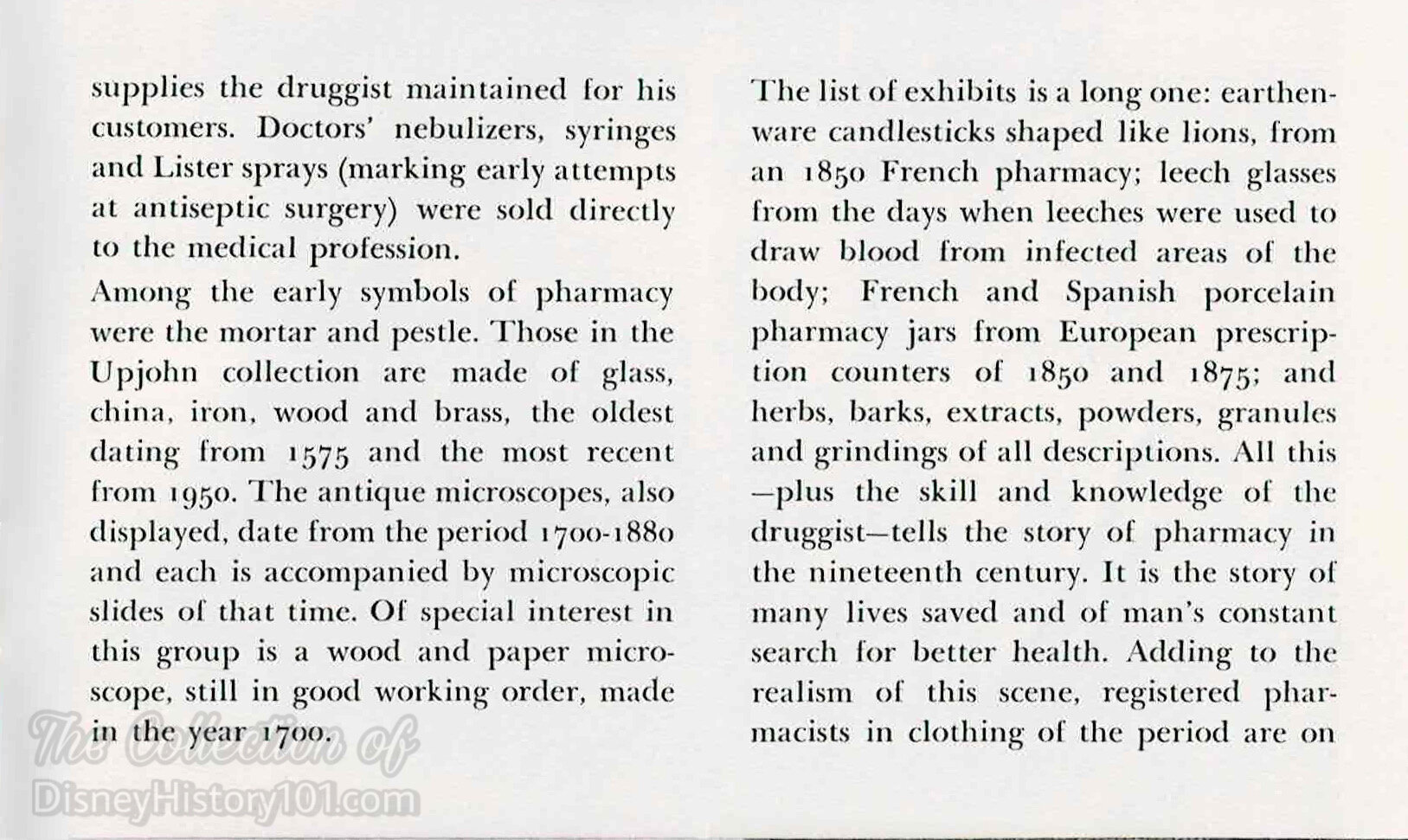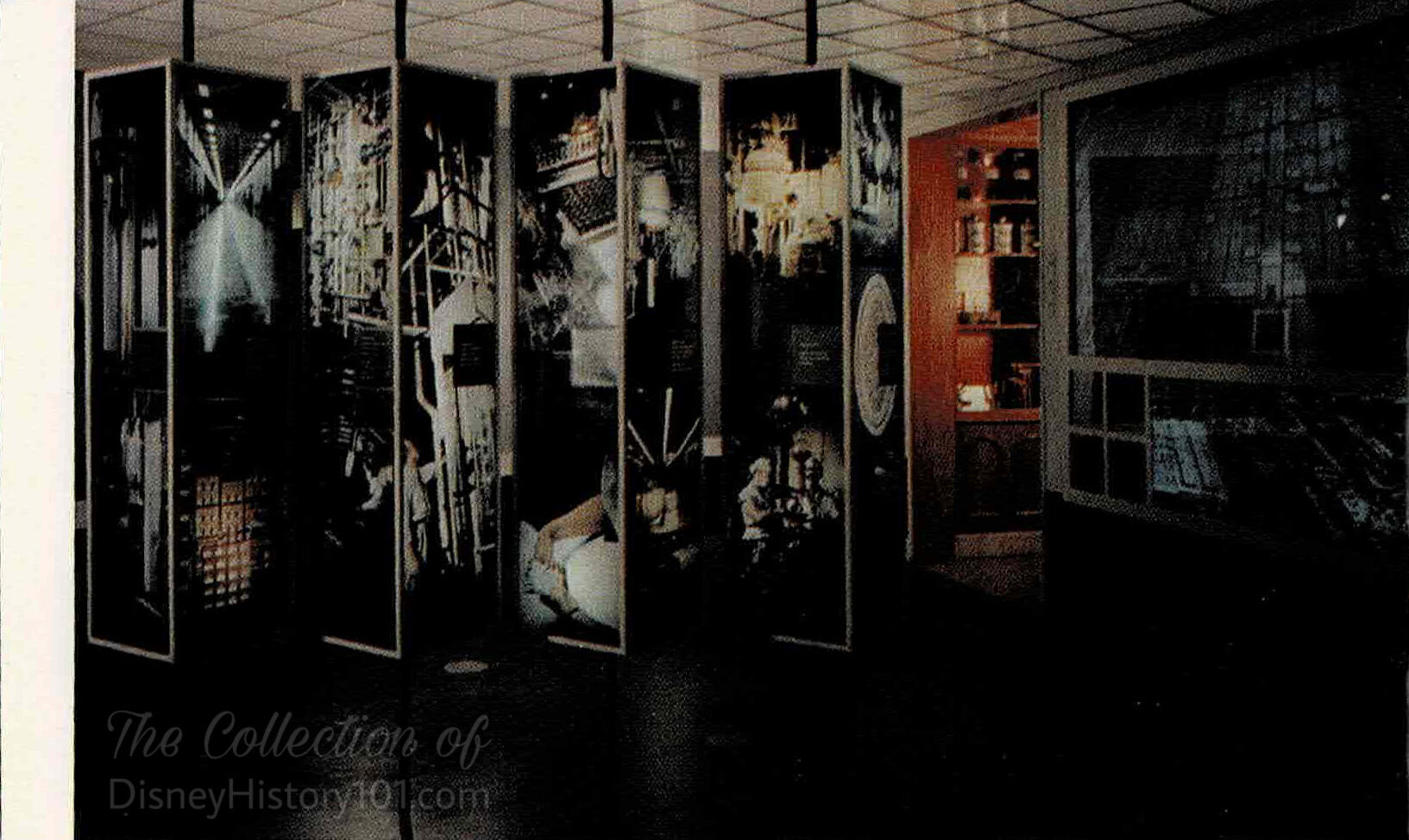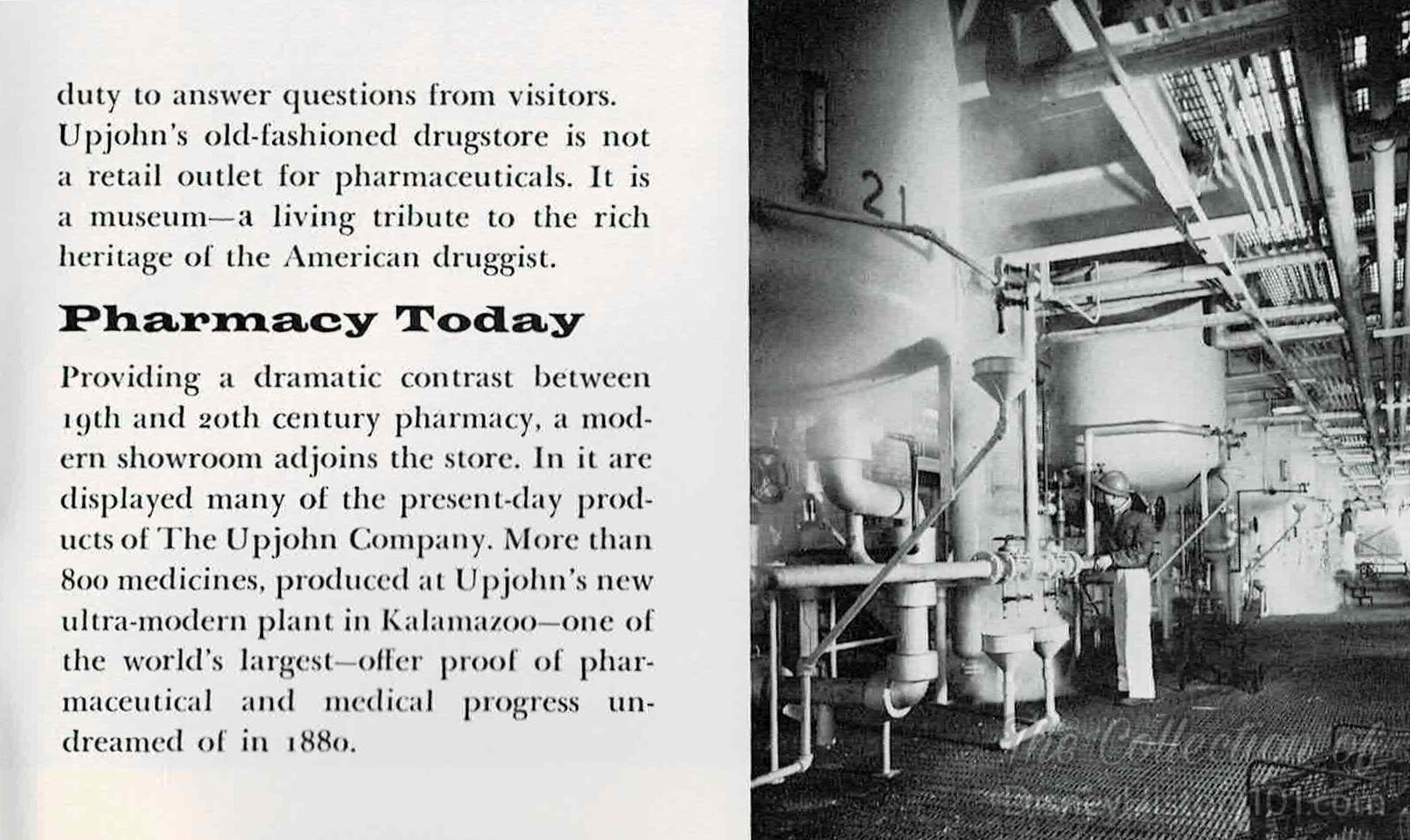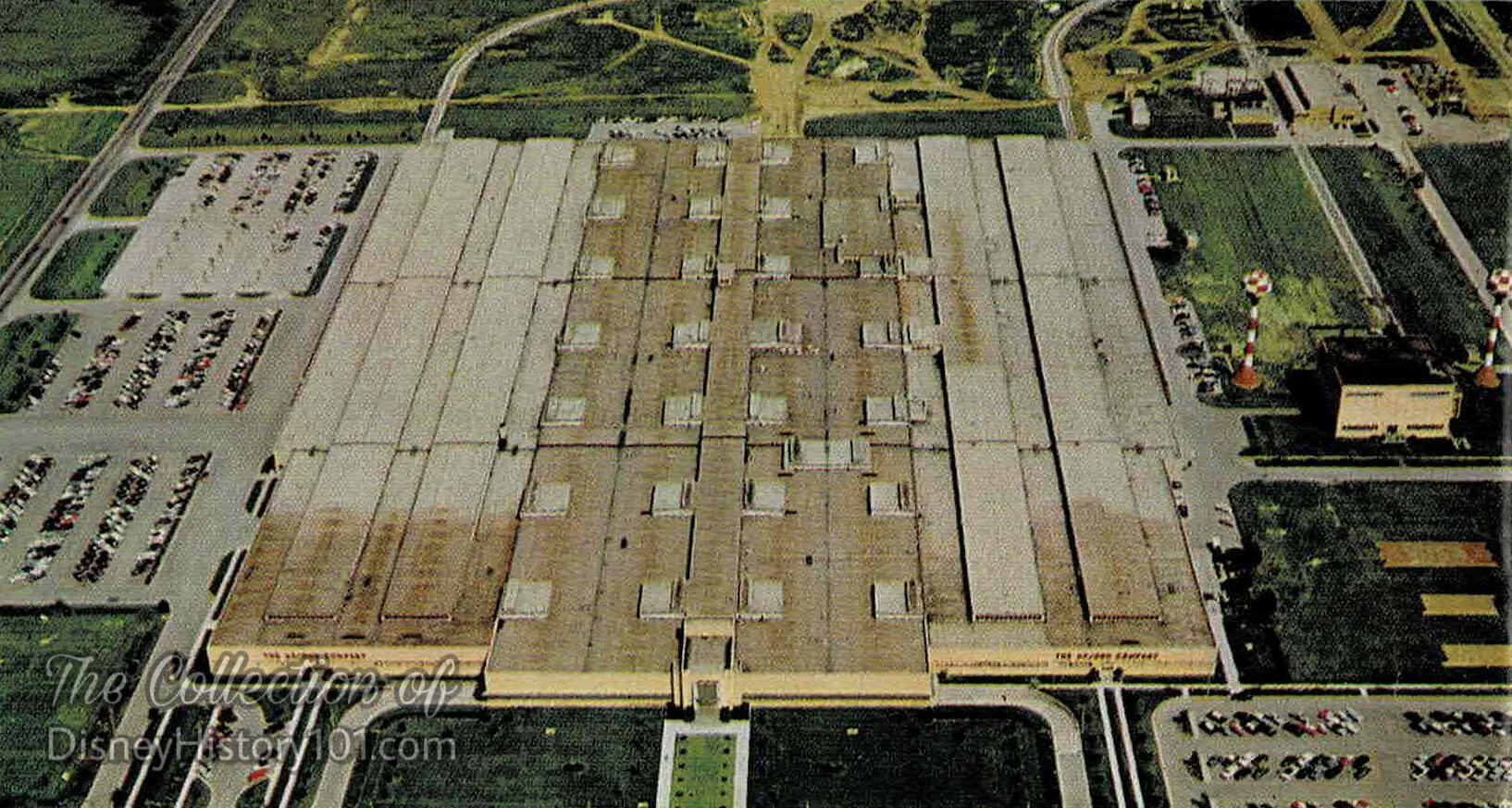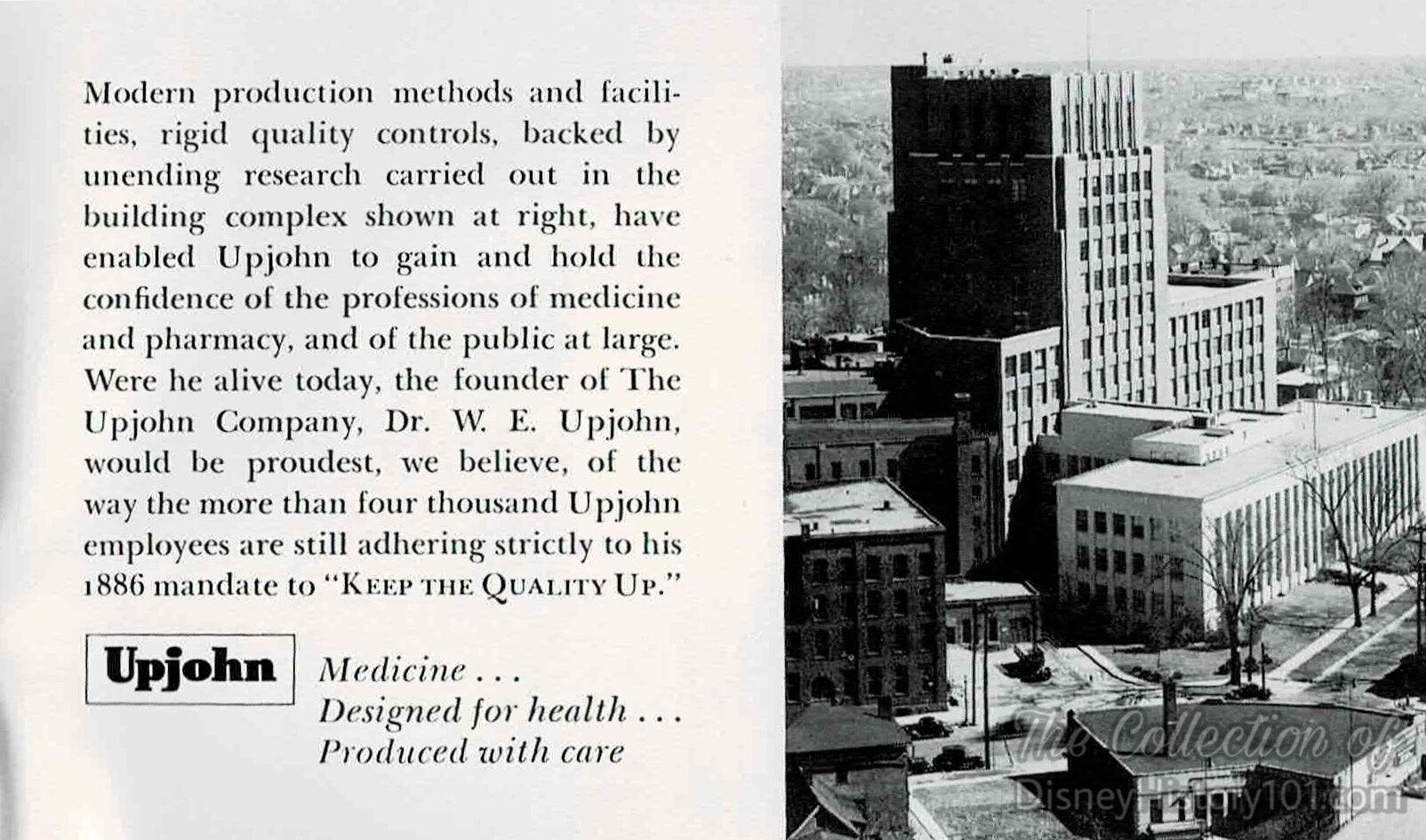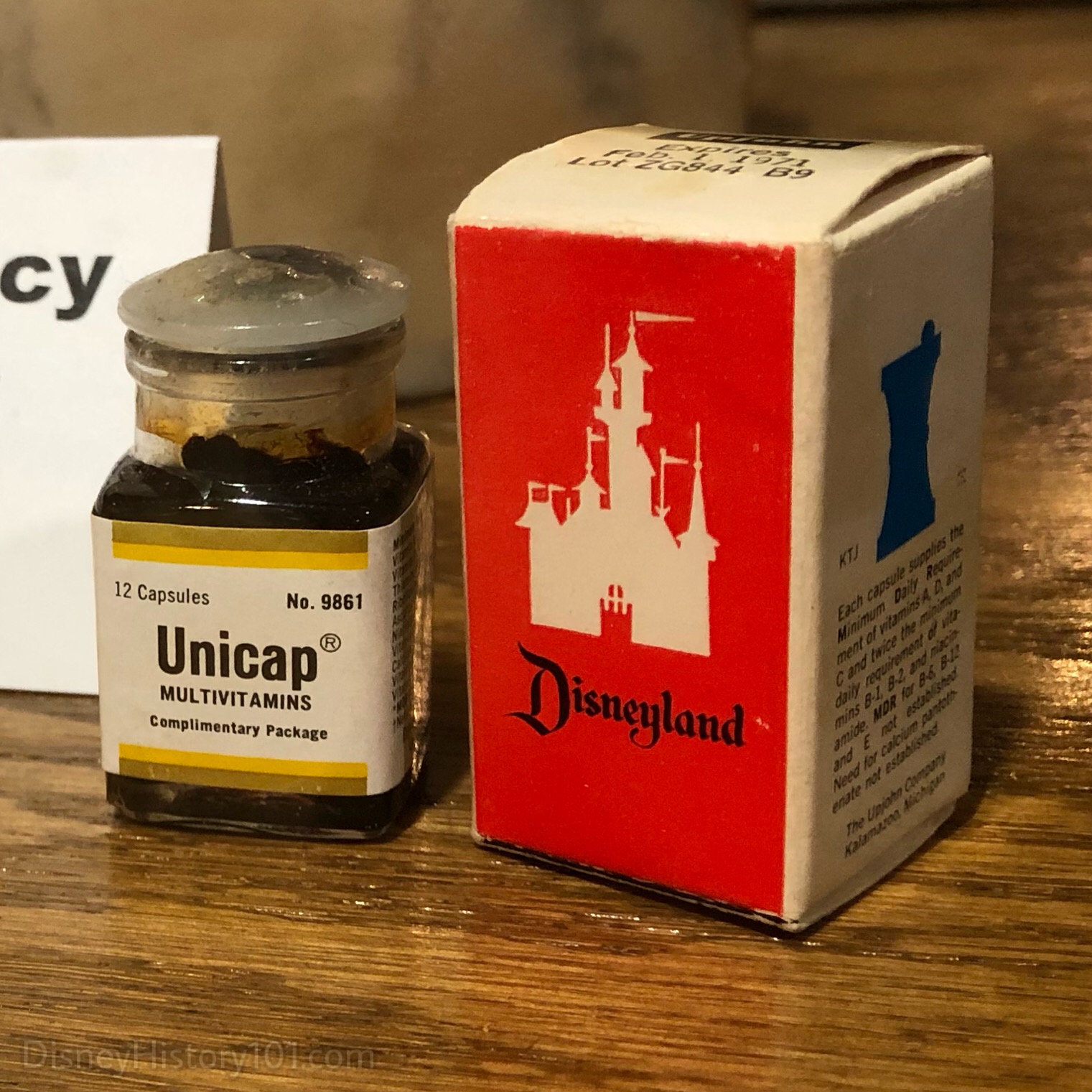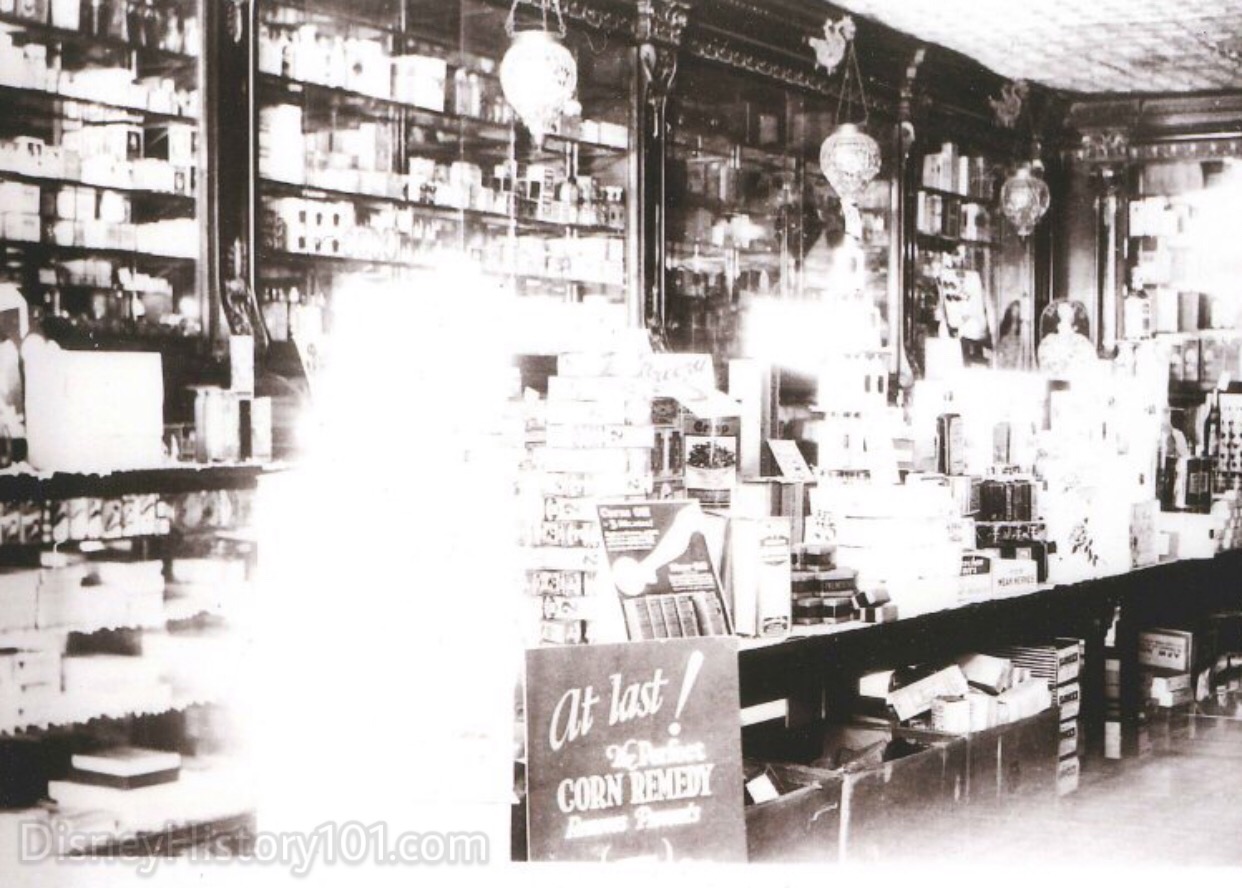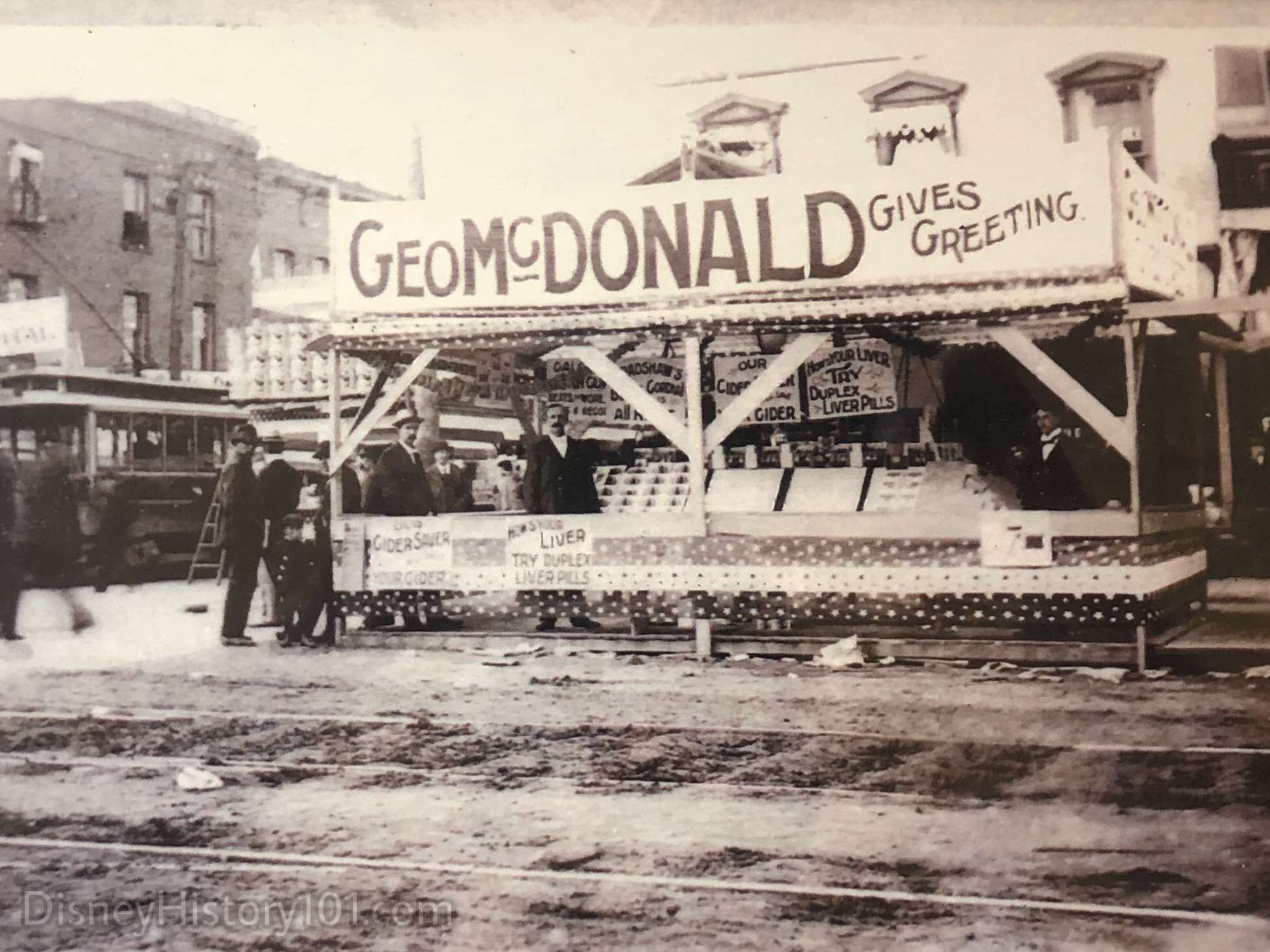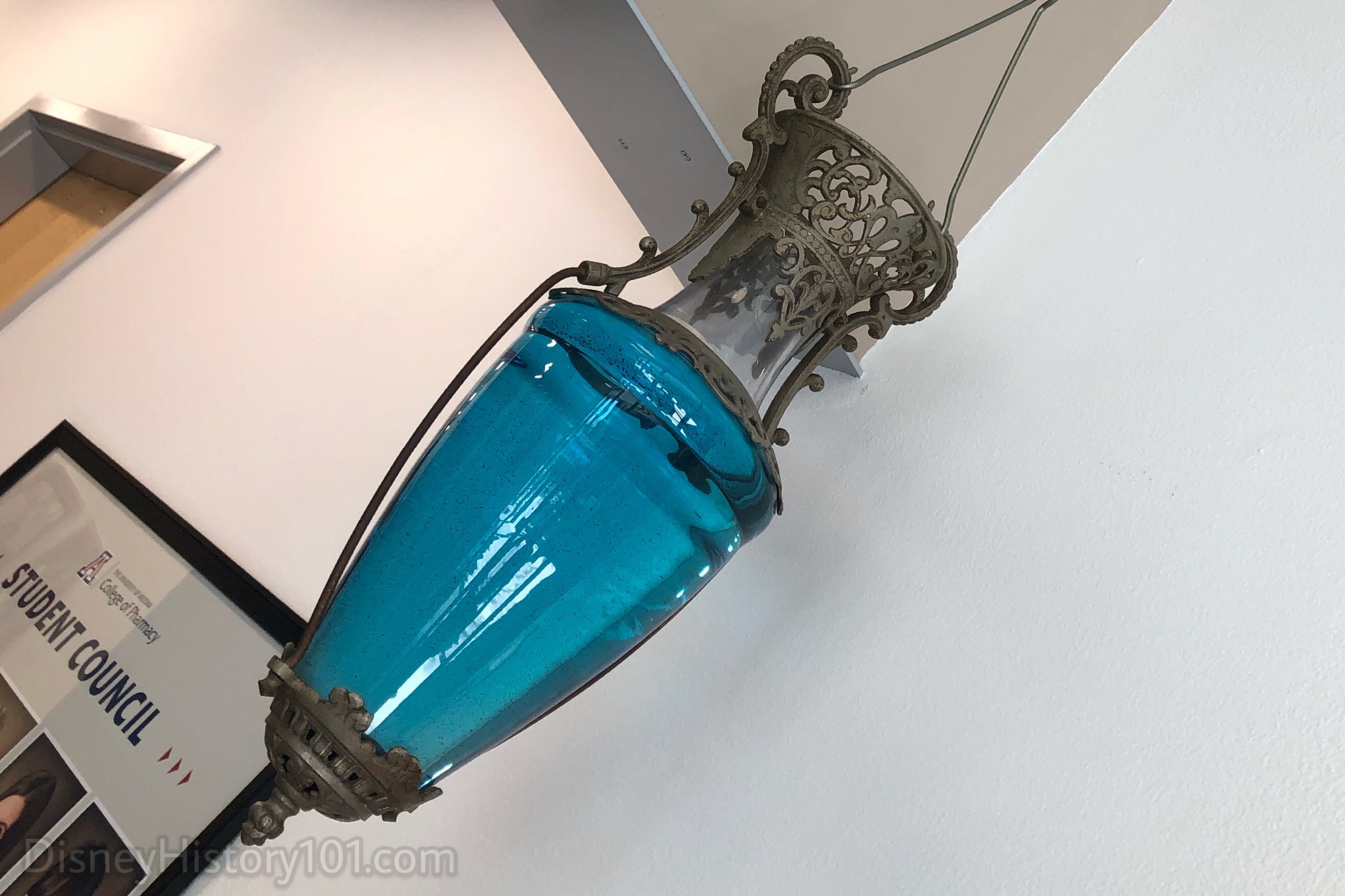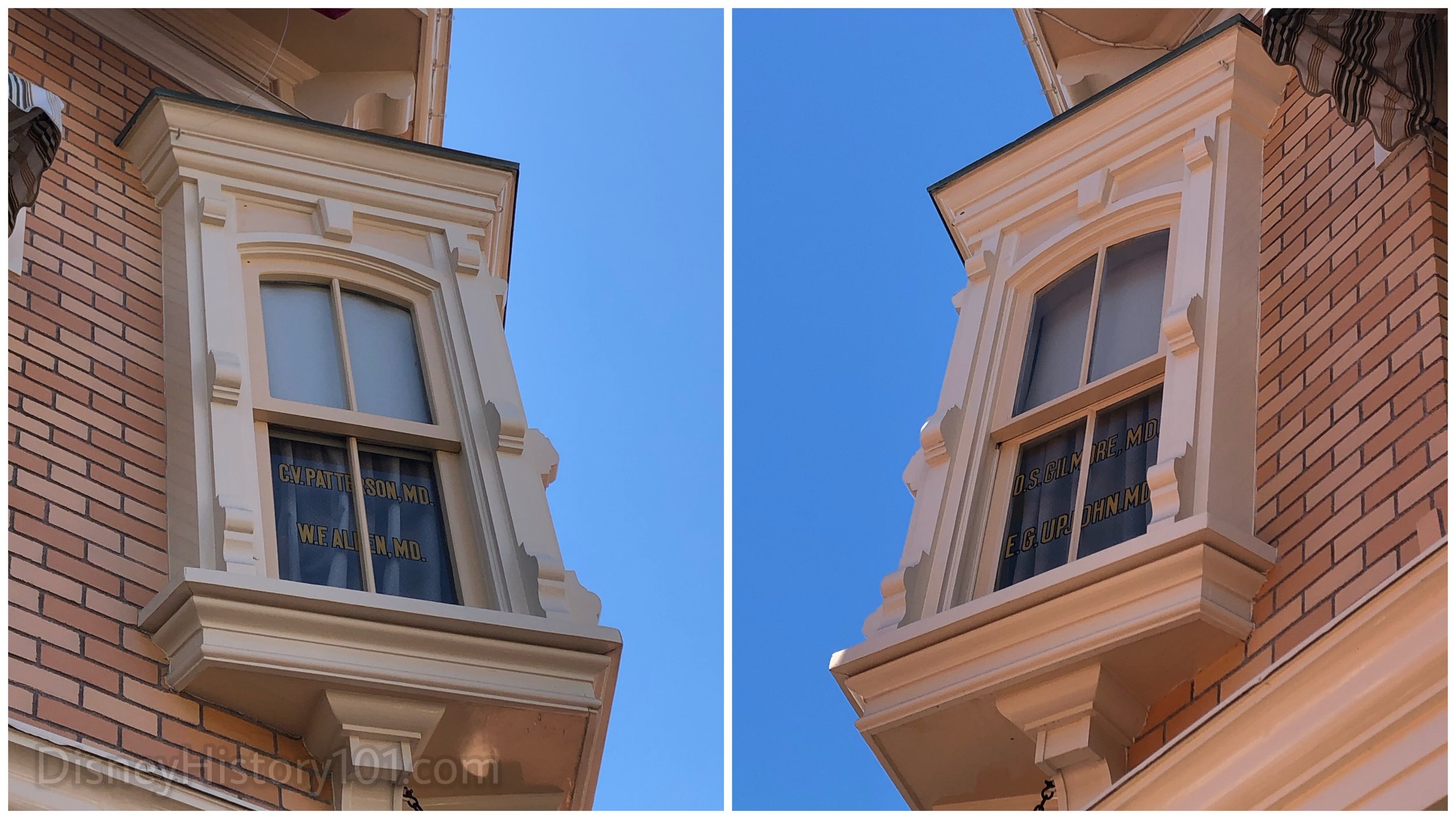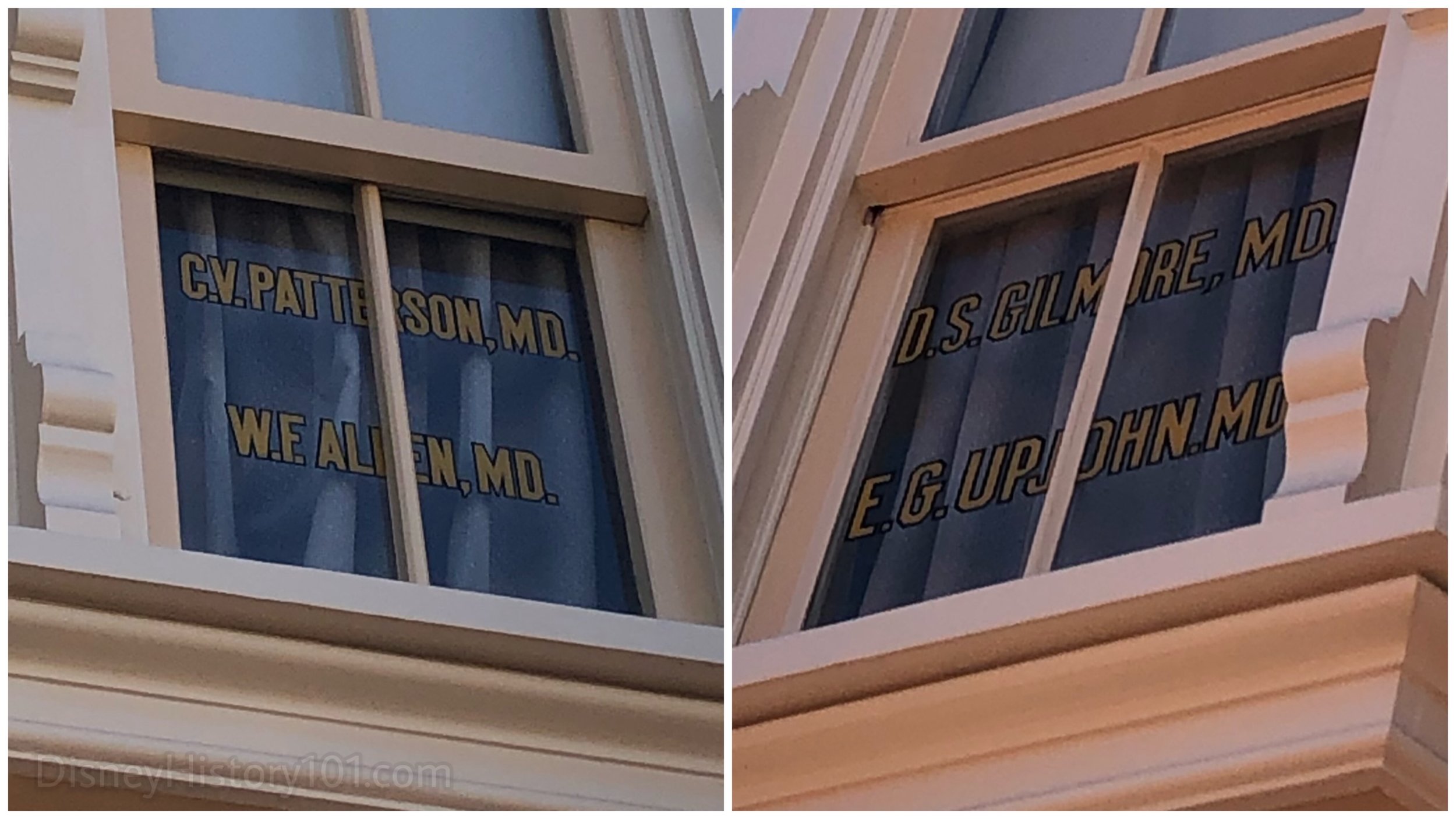I invite you to “drift back in time” to bygone days of a Walt-era Disneyland, and take a stroll down Main Street U.S.A.! As we leave Town Square, the smell of freshly popped corn kernels and warm peanuts lingers in the air. We can hear horse hooves mingled with distant hammers striking Wurlitzer piano music wires while passing Emporium window displays & the Crystal Arcade’s skilled glass blowers. As we approach the intersection of Center Street & Main Street U.S.A., our eyes turn upward toward a jeweled lamp in the shape of a physician’s mortar and pestle - the symbol of Main Street’s own little corner drug store! Please step this way, as we explore Upjohn Pharmacy also known as the “Main Street Apothecary” (1955 - 1970) - an opening day Disneyland attraction!
The corner of Center Street and Main Street, circa September of 1955.
“IT ALL STARTED…WITH A VACATION HOME”
Before we step inside, I simply must share how a replica Victorian-era apothecary ended up among Disneyland’s line up of Main Street shops! While Harper Goff would base some early c.1951 Mickey Mouse Park concepts on his own hometown of Fort Collins, Colorado, the origin of Disneyland’s Upjohn Pharmacy begins (not with his or Walt’s recollections of some small town druggist).
This early concept for a Drug Store was prepared by Harper Goff ; Walt’s Carolwood Barn Museum; Courtesy of the Walt Disney Imagineering Art Library.
Disneyland’s Upjohn Pharmacy actually owes a great deal of its existence to Upjohn Corporation’s Advertising Director, Jack Gauntlett. The year was 1954, and as the creation of Walt Disney’s magic kingdom in Anaheim was in full swing, it began making national headlines. Periodically, Walt would treat the public to televised and printed “progress reports” featuring details of what the five cardinal lands would ultimately look like. The news reached near and far - clear to Kalamazoo, Michigan, where Jack began to entertain the idea of advertising the Upjohn name inside Walt’s “up-and-coming” park. One day, Jack casually pitched the idea to his boss Donald Gilmore (then Chairman of the Board and Managerial Director of Upjohn Corporation) . Unbeknownst to Jack, Donald Gilmore (of Kalamazoo, Michigan) happened to own a vacation home at Smoke Tree Ranch where the Disneys would often go to relax. In fact, Don and Walt were seasonal neighbors there, and amidst lawn bowling competitions and barbecue dinners with fellow colonists, the two had struck up a close friendship. That friendship would lead to synergistic partnerships involving the Kalamazoo Institute of Fine Arts, Choinard, and the Gilmore Car Museum). For now, Disneyland was in development, and Walt Disney was actively seeking sponsorship for his park, so it wasn’t long before the topic casually came up in conversation around the campfire.
“A SOURCE OF… INSPIRATION”
According to a SCOPE article from 1955, Upjohn’s “only reason for sponsoring the store is that its presence constitutes sound, inexpensive, advertising with exciting possibilities. As Disney reaps the profits of his latest work, Upjohn will get full advertising value. This is permanent value too.” But how would such advertisement be achieved while not detracting from Disneyland’s ambiance? The result was a presentation of the Upjohn name to be capsulized within a “turn-of-the-century” Victorian apothecary shop.
True-life turn-of-the-century East Coast pharmacies were visited and photographed. The following never-before-seen photographs come from Upjohn’s Disneyland-related archival files, now in the care of the University of Arizona. As you CLICK the following gallery, you’ll notice a few derivative antiques and elements (of these research photographs) that would ultimately become a part of the final show piece at Disneyland!
After much research was conducted, WED Enterprises, Inc. employees Stan Jolley created exterior designs, and Harry Johnson (who was tasked with Main Street interior concepts) drew plans of what he believed the inside of an 1886 pharmaceutical shop would look like. (As a sidelight, Harry would be appropriately be honored with a window above the Bank of America on Main Street.)
Elevations for Building Number 308, which would include the Upjohn Pharmacy exhibit.
Elevations for Building Number 308, which would include the Upjohn Pharmacy exhibit.
Please CLICK the following window, and browse a collection of rarely-seen original WED Enterprises, Inc. interior designs (likely by Harry Johnson) for Upjohn Pharmacy at Disneyland. Some images may be subject to copyright.
Early thumbnail sketches and other concept artwork of Disneyland occasionally seemed to be unencumbered by restrictions of budget, schedule or the laws of nature and physics. Though guided by Walt, his artists appeared to engage in “free-thinking,” as if implementing the modern “Blue Sky” Imagineering process. Like some advanced “High Concepts,” many final designs were quickly generated and approved while others were voided. However, the WED-produced designs of Upjohn did not meet the approval of historian and medical antique collector Doctor Garrard MacLeod who scrutinized them and found them “not-so-faithful.” According to a 1955 issue of Upjohn Company’s SCOPE magazine, “there has been some disagreement on the architectural authenticity of the pharmacy itself.”
In response to this discrepancy, Doctor Garrard MacLeod approached Will Burtin (SCOPE magazine’s Art Director, and resident graphic designer), who dreamed up a fact-based layout of the building. It was this layout and its inclusive elements (as the corner window near the Arcade entrance, and five entrances), which gained final approval by Garrard. These architectural drawings helped define all designs, production and construction strategies, costs, schedule, and resource requirements. In fact, many of Will’s period specific architectural elements have stood the test of time, and are still in existence within Disneyland’s Fortuosity Shop today.
A floor plan of the Upjohn exhibit.
So, Upjohn’s artists would be mostly responsible for the floor plan and layout of the exhibit, while the WED Enterprises, Inc. artists would be responsible for the exhibit building’s exterior facade. Will Burton fabricated models to explore the various dimensional relationships, site-lines, flow patterns, ergonomics, and visual appeal to convey the desired creative intent. Architect Earle G. Kaltenbach and Italian Art Director Gabe Scognamillo were both contracted by Walt Disney’s WED Enterprises Inc. to create many detailed concepts, elevation drawings, and other architectural artwork which ultimately became the final facade product, and which supported Upjohn’s revised floor plans. Though we don’t know much about Earle G. Kaltenbach, Gabe Scognamillo was instrumental in developing another crucial realm of Disneyland! Gabe contributed designs of exhibit halls, an “Automat,” and many of the “hairpin” supported yellow canopies, for what was perhaps the most challenging land of all - Tomorrowland! Gabe is responsible for the designs of the original (c. 1955) Richfield Autopia neon sign as well as the fuel pumps near the Loading Zone.
The caption for this Monsanto Magazine image reads : “The Upjohn end of the Disneyland business is being handled by the two men in this photo, Advertising Director Jack Gauntlett and Design Consultant Will Burton. Semifinal architectural drawings were converted into model of the drugstore so that traffic patterns could be better studied, and so that the modern exhibit and the Victorian store will not conflict. Removed widows (left foreground of model) expose modern exhibit. Four rectangular boxes are the revolving Kodachromes mentioned in the text.”
“Construction”
“When the giant earth-moving undertaking was completed, the building crews took over. Soon, the rat-tat-tat of riveters was shattering the air, and sparks were flying from welders’ torches as the steel frameworks, capable of withstanding the ravages of time and the elements rose above the newly formed ground. While carpenters hammered and masons laid row upon row of brick and stone and mortar, the permanent buildings began to take shape and form,” according to “The Disneyland Story” published 1955.
One of the first buildings to be constructed was the Main Street Opera House, which was used as the Mill. Here, the woodwork of Disneyland (including the Upjohn Pharmacy) was generated - from the functional to the aesthetic! The lumber was fashioned into the framing belonging to the very first buildings constructed at Disneyland - primarily the Main Street Complexes (on each side of the street). In addition to framing, “cabinet-makers carved and painted the accurate reproductions that furnish the buildings,” according to “The Disneyland Story.”
Much of the wood was processed by McNeil Construction (which formerly constructed Walt Disney Studio sound stages in 1947 and 1953), and under the direction of George Mills Sr. (the Prime General Contractor and Mill Foreman). George Mills Sr. was under the direction of Charles Alexander and Ray Conway (Construction Field Supervisors) and ultimately Joe Fowler (Construction Supervisor).
Upjohn Pharmacy was constructed at the corner of Main Street and Center Street - at the hub of major pedestrian traffic. As this would be an ideal location for advertising the Upjohn name to passerby and guests, work quickly got underway. Work began on the 11,860 square-foot Main Street Building #300 that would the 1,480 square-foot Upjohn Drug Company. In constructing the building, a concrete foundation and slab floors were prepared, followed by wood frame construction (while store units would have a combination wood and rigid steel frame). “The first fabricated steel for the Main Street buildings arrived November 8 and was erected,” according to the narrator of “Disneyland - The Park,” a Disneyland anthology television series excerpt, first aired 1957 and Disneyland LINE (November 22, 1979). The roof covering was a variable, dependent on the architectural design. The building (as each on Main Street U.S.A.) possessed complete fire sprinkling systems.
Now, the deadline was nearing. As of June 2, 1955, C.V. Wood Jr. sent an Inter-Office Memorandum to Walt Disney regarding the best estimates that could be obtained at the time regarding the status of individual sections of the Park and Opening Day. C.V. wrote: “Building #307 - Upjohn: The construction of the walls and fixtures will be complete. A lot of the props are here now. We do not know if this is all there is to come and if not, if it will all be here for opening.” By the night of July 16th, 1955, the 1,480 square foot Upjohn Pharmacy was still not finished. In fact, one store employee recollected that nails were still being driven into the walls past midnight before Disneyland’s opening day. Even more, some exhibits were missing little details like pills inside bottles. The interior of the drug store was incomplete, so no inside photos were taken for Scope magazine’s May/June progress report. Still, this version of Upjohn Pharmacy was “just what the Doctor ordered” and would contribute greatly toward Walt’s enjoyable and inspirational vision of carefree times!
The Upjohn Pharmacy was an opening day attraction at Disneyland (though it was incomplete). By August 4th, 1955, the famous mortar and pestle stained glass lamp (which once adorned a 19th-century apothecary in Philadelphia) was still not attached to the building’s facade. (Photo : Disney History 101)
By July 17th, 1955 many Upjohn employees (some of them doctors), were excited to make a house call on the final product. Many employees were invited to Disneyland’s Press event.
Complimentary Disneyland Main Gate Admissions for Upjohn Company employees.
Scope magazine reported, “Eighty tickets had been issued to West Coast Upjohn people and their families; many of them were able to make it, and joined the 17,000 people who were having the official first-look at the place.”
Window displays have always played an important role -communicating to guests the essence of a shop and were designed to invite guests into the store. These may be animated or still and would also include props used for display purposes. Here, we can peer inside the storefront windows of Upjohn Pharmacy, c. September of 1955; Collection of the University of Arizona.
Though Disneyland’s opening day included many formal ceremonies, it was not until the following day, that a modest ribbon-cutting ceremony took place in front of the Upjohn Drugstore. Two ribbons were cut - one by Fred Allen, and the other by “retail association brass representing West Coast druggists.” Finally Upjohn was officially open for “business.” As you can see from the following photograph (taken 1 - 2 months later), the store’s facade had been completed.
The completed Upjohn Pharmacy (on the corner of Main Street U.S.A. and Center Street), c. September of 1955, as seen by Jerry (a former employee of Upjohn Pharmacy).
Most Disneyland guests fondly remember entering the front room - a veritable Victorian Apothecary Shop. The smell of freshly-ground sassafras (put through the mill) filled your nostrils as you stepped beyond the threshold. As your childhood eye surveyed the surroundings (of elaborately detailed ceiling tiles & elegant wall paneling), you no-doubt were impressed with the “more than 1,000 items dragged from attics, antique shops, doctor’s offices and shop windows by Garrard MacLeod.” Of these, "More than 100 items were purchased from an antique dealer in Charleston, South Carolina,” according to one Upjohn-sponsored publication. “The Upjohn Drugstore in Disneyland” (published c.1957) expands, “well over 1000 antiques were collected by the personnel of the Upjohn Company in a search that took them to auctions, attics, old pharmacies, dealers, and historians in New Orleans, Chicago, New York City, South Carolina, Michigan, and New Jersey.”
The interior of the Upjohn Pharmacy exhibit.
The result of this “treasure hunt” was a main room full of those antique (in fact, some of the earliest) syringes, atomizers, old cosmetics (dating from 1900, or earlier), bed warmers, nebulizers, and other equipment that pre-dated 1900. There was an amputation set used during the Civil War period, “prior to the advent of anesthesia and sterilization” and Lister sprays (“marking early attempts at antiseptic surgery”). One of the more unique showpieces on display were “two ledger sheets which were kept by a physician who attended the owner, family and slaves on a Georgia plantation between the years 1852 and 1859.” There was a collection of “glass, china, wood, and brass, the oldest dating from 1575 and the most recent from 1950.”
Take a look around the pharmacy counter. Yes, those were actual live leeches in the jar! Until the 19th century leeches have been used to draw blood from parts of patient’s bodies, and treat a variety of joint diseases.
Perhaps you can recall churning the crank on the 75-year-old (Jackson, Michigan) drug mill used to grind drugs for prescription. Or maybe you recollect peering in wonder at some of the antique microscopic slides, through one of the antique Leuwenhoek or compound microscopes, dating from 1700-1880. (As a “sidelight,” one of these historic microscopes was actually made of paper and wood, during the year 1700.) You may even remember looking into the jar of live leeches. And who can forget the colorful “early American, English and Scottish (Glasgow) show globes”? When this exhibit first opened at Disneyland, there were only about a half-dozen apothecary shops left in the United States of America, making this experience truly a rare one!
Pharmacist Frederick August Ekstein watches guests from behind the Upjohn Pharmacy counter display. Overhead, twelve c.1890 German leaded glass fixtures provide light to the Upjohn store. The entryway to the right leads to the Upjohn Pharmacy Modern Room and opens into the Crystal Arcade.
“IS THERE A DOCTOR IN THE HOUSE?”
The answer to that question is, ‘yes’ - at least three of the original employees were fully licensed pharmacists working behind the counter! All four friendly Upjohn Company employees (dressed in turn-of-the-century period pharmacist clothing), greeted Upjohn Pharmacy visitors. The lucky individuals were Frederick August Ekstein (Pharmacist), Betty Lou Foley (Clerk), Juanita Eloise Goodwin (Clerk), and Philip Milton Harvey (Pharmacist). Many local Upjohn Company guests fondly remembered Betty Lou Foley, because she was the wife of Salesman Basil Foley who worked at Upjohn’s local Los Angeles store since 1942. A fifth employee - Leo B. Austin (former sales manager of Upjohn’s Los Angeles branch) worked behind the scenes as manager of Disneyland’s Upjohn Pharmacy.
“The Disney magic began” with the faces of Main Street U.S.A.’s Upjohn Apothecary Shop - Philip, Juanita, Frederick, and Betty Lou!
Most Disneyland Hosts and Hostesses hired during 1955, were “hand-picked by Disneyland officials with qualifications including disposition, general attitude and appearance. Each new Disneyland employee was required to attend ‘orientation classes,’ part of a training course in Disneyland policies, to become acquainted with the Disneyland way of life,” according to “Building A Dream,” prepared by Disneyland, Inc. Public Relations Department, c. June of 1955. And by June 10th, 1955, “Hal Hensley… [was] holding classes to train the estimated 1,200 employees in how to meet Disneyland’s public.” Those fulfilling roles at the Upjohn Apothecary Shop needed instruction in some of Walt’s personal philosophies, as well as the policies which would “create happiness” for visitors! Despite their 1890 On Stage setting, Hal wanted to ensure that Disneylanders to “get a ‘new world’ feel about this place.” It is likely, that these five employees of Upjohn attended these courses (of the Disney University Orientation Program ; under the Direction of Van France and his assistant Dick Nunis), in preparation for the big Press Preview Day. Even years later these had become part of the Disneyland family, participating in Disneyland Recreational Clubs (e.g. Frederick Ekstein was President of the Disneyland Gun Club).
Leo B. Austin, as pictured in The American Home (September, 1956), “shows us this collection of handsome French and mid-European apothecary jars used 100 to 150 years ago”.
Though little (if, any) true-life drug compounding was performed on the museum premises, children of all ages may recollect watching these individuals (like registered pharmacist Phil Harvey below; depicted in “Disneylander,” published September of 1958) perform demonstrations of some of the amazing tasks that pharmacists once did. This they showed Guests, from behind the counter (grinding, mixing, preparing, and dispensing). In remembering the contributions of these professional Upjohn employees, we recall the following words printed in the c.1957 souvenir “Upjohn Drugstore in Disneyland”: “Were he alive today [c. 1957], the founder of The Upjohn Company, Dr. W.E. Upjohn would be proudest, we believe, of the way of more than four thousand Upjohn employees are still adhering strictly to his …mandate to ‘Keep The Quality Up.’”
While we are on the subject of doctors, we are reminded of the following excerpt featured in Disneyland Backstage magazine (during the Spring of 1966).
A comedic interlude courtesy of those loony contributors to Backstage Disneyland Magazine, Spring of 1966.
“MODERN MEDICINE”
Around 1958-1959, a new exhibit opened within a secondary room. The contemporary-style Modern Display Room, valued by Bank of America appraisers at $15,000. The Modern Room exhibit housed a display documenting the history of the old Upjohn Pill and Granule Company. Other displays presented the then (1950s - 1960s) present, as well as the future of the Upjohn Company.
The Upjohn Exhibit is depicted on a Twenty-Scale Plot Plan by Weldon Paige; 1968.
In an interview with Upjohn Company graphic designer Will Burtin (published in Industrial Design magazine, May of 1957), he states that “Upjohn’s purpose in spreading the visual news is to help its specialists as well as its customers to realize the breadth of company research.” This mission was effected with the Modern Display Room. This was an important part of the exhibit, for “modern production methods and facilities, rigid quality controls backed by unending research carried out in the [Kalamazoo] building complex … have aided Upjohn to gain and hold the confidence of the professions of medicine and pharmacy, and of the public at large,” according to the c.1957 souvenir “Upjohn Drugstore in Disneyland.”
Upjohn Company’s full line of products (over 800 medicines) were showcased, in an exhibit centered around the Pharmacy School of the Month promotion.
Four illuminated rotating columns (bearing select drug manufacturing processes) were synchronized to electronic recordings. One wall had a special illuminated display showcasing Upjohn’s new manufacturing plant on Portage Road in Kalamazoo, Michigan. Sadly, we do not currently know what happened to any of those dated corporate display pieces.
Upjohn Pharmacy’s Contemporary exhibit with four rotating light boxes (about research, clinical research, production, and distribution) and illuminated Portage Road plant aerial photo (on the right), c. September of 1955, photo courtesy of the University of Arizona. Added to this Contemporary Exhibit during “the spring of 1966” was “a display that illustrates 20,000 years of medicine history,” according to the “Disneyland Dictionary” (compiled by WED Enterprises, Inc. and WED Public Relations Department, c. 1968).
Though Complimentary Souvenir Books have preserved highlights of the Upjohn Pharmacy (to this day), their contents were limited.
The Modern Room also featured additional displays over the years like a display illustrating 20,000 years of medicine history added July of 1966. A memorable display was this dynamic Human Cell Display model designed by Will Burton (Upjohn Company resident graphic designer, and “Scope” Magazine Art Director) as an educational tool for physicians, cytologists, and students. Will had previously manufactured many displays and exhibits for Upjohn - models of proteins, models of vitamin pills, X-ray refraction patterns - usually on exhibition at the Kalamazoo Art Center. Now, Upjohn commissioned a total of three models of the human cell. By September 28, 1958, Disneyland Inc. job number 4012-515 for the Upjohn Company “Micro-world exhibit” was in progress at a cost of $13,056. Nearly a year later (by October of 1959), Upjohn Pharmacy had a free Human Cell Display according to the Disneyland Dictionary.
The original (and much larger) Upjohn-sponsored model (which was a precursor to the one appearing at Disneyland), first required a year for “its research, its collation of fact and surmise, and for its construction. Representative of no particular part of the human body, it is an abstraction of the cell - but a controlled abstraction, as technically accurate as the knowledge and conjecture… could make it.
Magnified more than 1,000,000 times the size of a human red blood cell, the model is [more than 20] feet in diameter and 11 1/2 feet high [though Disneyland’s was much smaller in dimension]. It sits on a metal mirror, so that as a viewer walks through and around, he has an impression of being inside the organism, at the center of it. The model is constructed of acrylic plastic tubing for the cytoplasm, or the outer material. There are some 2200 pieces in the cytoplasmic structure, measuring 3700 linear feet, their 7500 joints connected by hand. This…structure is built on a five-piece irregular module regularly repeated with the pieces…[fitted] together at an angle of 78 degrees. Along the… ‘wall’ are displayed scale models of all the elements of the cell. Because nothing of its kind has ever been attempted before, new problems of conception required novel solutions in construction, for example the chromosomes {the long curly forms in the nucleus} are made of vacuum cleaner [hoses],” according to Industrial Design magazine (published August, 1958).
Still, the smaller version that exhibited at Disneyland, featured many of the same parts of the “organic whole” display - from the transparent and rigid mitochondria (where food is transformed into energy), to the flat sack-like endoplasmic reticula (believed to once be responsible for the formation of the cel’s proteins)! This display was so popular that it was moved around and displayed in several places (after its Disneyland exhibition), and it was even featured on a Disneyland postcard during 1960!
“IT BELONGS IN A MUSEUM!”
The Upjohn Pharmacy was open for business on Main Street U.S.A. for some fifteen years. Ultimately, Disneyland Participant Affairs and Disneyland Participant Upjohn Company could not negotiate a new cooperative agreement to maintain their ongoing synergistic relationship, so the two “reliable old firms parted ways.” We do not know why the company pulled out of sponsorship, but The New Century Clock and Watch Shop swiftly took their space during 1970. Suddenly this amazing collection of antique pharmaceutical wares (and Disneyland props) had no place to call home. Much of the furniture (as the original woodwork and showcases) may have suffered a fate similar to that of Monsanto Plastics Home of the Future and the Clock of the World. Were they re-purposed somehow, or just dismantled and disposed of? We may never know.
This Upjohn Pharmacy display was dedicated to liquid extracts (like oils) which carried certain medicinal properties.
But the medical antiques were in fact saved. The California Museum of Science and Industry (known today as the California Science Center), happily made room for the Upjohn Collection. According to one curator of the museum, the Upjohn Collection was to become part of a proposed wing devoted entirely to the history of medicine. Unfortunately, these plans never materialized, and the Upjohn Collection remained in storage for some forty years.
The mortar and pestle in the Upjohn collection were made of glass, china, iron, wood and brass, the oldest dating from 1575. Above, this “charming Persian bluebird” (used for administering “medicine, feeding infants, and drinking”) and this 100-year old mortar and pestle were among Upjohn’s medical antiques in the Disneyland exhibit! Photo Credit : The American Home (September, 1956)
Fast forward to the Fall of 2007, when the California Museum of Science and Industry was being overhauled. Any ideas of a medical wing were long forgotten, with many engaging and interactive displays replacing static displays. Amidst all the innovations and renovations, there just wasn’t a present space to be found for the preserved Upjohn Collection. So the museum’s Director began to search for the Upjohn Collection’s new home. The ‘first responder’ was the University of Southern California (with its pharmaceutical program), which was considered a prime choice due to its proximity to Disneyland. But when that university had no facilities available, it was The University of Arizona that ultimately stepped forward to give urgent care to the Upjohn Collection. In 2014, the items were dusted off, cataloged, and properly arranged for public display. Please step this way, as we take a closer look at some of these “vintage” Disneyland items, and imagine ourselves within the walls of Upjohn Pharmacy, circa 1955.
“A ‘ONE-OF-A-KIND’ COLLECTION”
The University of Arizona has taken great care with the presentation of this unique collection. Duplicate display show-cabinets (based on restored amateur photographs of the Disneyland originals), were constructed to house the immense collection of antiques (some more than 200 years old). These cases were carefully crafted by individuals in the University of Arizona’s carpentry shop, and loyally mirror the details of the original.
You might remember one of those licensed pharmacists measuring compounds with an apothecary scale located behind the prescription counter. The base of this authentic c.1840 French Balance is made of polished marble, while its pillar is of white porcelain decorated in gold with silver-plated bands and trays. The balance is comprised of silver-plated brass. The entire piece was once utilized in a French pharmacy and was among the more than 100 items that were purchased from an antique dealer in Charleston, South Carolina.
Note the ceramic jars and canisters containing various remedies for what ales your soul.
Those c. 1850-1875 French, Spanish, and mid-European ceramic apothecary jars and canisters sure had funny sounding names on them! That’s because a lot of the words were “taxonomic” names, written in Latin. The following jar is labeled “Papaver Somniferum,” which translates roughly to “Deadly Poppy Seeds” (which were once utilized as pain relievers, among other uses). These were 100-150-year-old antiques at the time of Upjohn’s tenancy on Main Street U.S.A., and by the pushing of this article, more than 200 years old!
If you’re in the medical profession you may even recognize a few of the nineteenth-century compounds that are still in practical use today - like Cardamom or Camphor oil. These jars originally contained “herbs, barks, extracts, powders, granules, and grindings of all descriptions,” according to “The Upjohn Drugstore in Disneyland” (published c.1957).
As you recollect earlier strolls down Main Street U.S.A., you may remember looking into the windows of the “Modern Room” and seeing several tall cylindrical, glass jars. The white glass cylinders bear plant names like Magnesia and Iceland Moss. The 40-inch blue blown glass cylindrical jars (though lacking names), carried intricately detailed paintings of plant compounds Foxglove and Larkspur. The tops of these jars are just as magnificent, as they were made of blown glass with gilded gold inside.
Let’s just take a moment to appreciate the craftsmanship of these stunning antique vessels, because each one (murals included), was painstakingly hand-painted in gold leaf from the inside of the glass. Because there were several of each style on display, it is believed that these antiques came from larger sets, and were once used to preserve medicines of the powdered variety. However, photographic evidence proves that these were likely the only ones ever on display inside Upjohn Pharmacy. Just look at the following photo (dated September of 1955), as these jars can be seen by passerby from the street.
These enormous olive oil vats are believed to be at least two centuries old by resident historians. They were included among the Upjohn Collection, but have not been seen in any early images of Upjohn Pharmacy at Disneyland. It is believed that, if they were used in the display at Disneyland, it may have been during a later date.
Two porcelain lion candle holders decorated one of the window displays near the “confections” jar. These pieces (dating from the late 18th century), were also antiques by the time Doctor Gerard MacLeod found them and donated them to Disneyland’s Upjohn Pharmacy. The earthen-wars lions originate from “a 1856 French pharmacy” and originally carried candlesticks bearing an Italian coat of arms, believed to have been out of use since the year 1750.
You might also remember some of these authentic tinted glass bottles. Some of these bottles were tinted Amber or Cobalt Blue. The color of the antique bottles would help preserve the quality of the product by protecting its contents from light and heat. Some of these bottles (like the ones pictured) still contain the pills that were part of their display at Disneyland.
Visitors did not leave the apothecary exhibit empty-handed. There were souvenir postcards and pamphlets available, as well as complimentary sample bottles of 12 Upjohn Unicap brand Multivitamins bearing Sleeping Beauty Castle on the label. During the era of their time as a Participant lessee, Upjohn revised their Unicap Multivitamin Supplement (adding Vitamin E), with slight revisions made to both the sample bottle package label and box.
“A Spoonful of Sugar” - Perhaps you remember being offered a piece of old fashioned candy from the confections jar in the display window. Though the candy was restocked regularly in the present, the French porcelain piece was at least 150 years old during the 1960s!
Over the counter, hung a clock above a metal sign. The clock was designed by Will Burton, and featured a three-dimensional wrought-iron rendering of Upjohn Company’s two-dimensional logo - a hand crushing a pill. Upjohn’s “claim to fame” was that their pills were “friable.” This meant that they were composed of such soft powder that they could be crushed “under the thumb” and give instant relief after entering the system. Upjohn staff would regularly demonstrate this pill-crushing process for Disneyland guests!
Some of the most stunningly gorgeous pieces were the stained glass lamps that lit the Victorian-era corner store. With the help of George MacLeod (son of Doctor Garrard MacLeod ), the University of Arizona was able to confirm the origin of the Six Stained leaded glass pendant lamps that once illuminated Upjohn Pharmacy’s replica apothecary shop side. Remember that Garrard MacLeod was the doctor and antique collector who was responsible for collecting the “one-of-a-kind” thematic elements that decorated Upjohn Pharmacy.
Around 1898, twelve beautifully hand-crafted lamps were purchased in Germany, and utilized to illuminate a Kalamazoo drugstore - the Dunwell Drugstore, until 1932. This fact was confirmed by Leo Austin (an Upjohn Pharmacy Manager), who worked in the very drugstore where they hung. Photographs (taken during the very first Kalamazoo street fair), show these lamps hanging prominently over the counter. Sometime after this event, the (then 90-year-old) lamps were acquired by Garrard MacLeod who stored them inside his drugstore basement.
The lamps were forgotten for some time until the ealry 1950s. George lived and worked in his father’s drugstore in Kalamazoo, Michigan. One day he was cleaning out a furnace hopper in the basement, sweeping up soot. As he was sweeping, he noticed six colorful glass lamps under the waste. George quickly dusted them off and brought the lamps to his father who incidentally was assembling a collection for Disneyland’s Upjohn Pharmacy. These character lights added to the overall appearance and complemented the interior of the show, but didn’t necessarily create enough illumination for operation.
Photographs of Dunwell Drugstore show twelve of these leaded glass pendant lamps. Arizona State University only received six leaded pendant lamps in the Upjohn Collection, so the whereabouts of the other six remain to be discovered.
Please CLICK the following window, to browse two 1898 photographs of Dunwell Drugstore of Kalamazoo, Michigan - the very shop that once contained the leaded glass pendant lamps.
On one of the upper shelves you may recollect a c.1800 dark wedgwood bust of the third-century physician Hippocrates - “the father of modern medicine.” His namesake is the Hippocratic oath, still recited by most medical graduates, which partially states, “to teach them this art, if they want to learn it, without fee or indenture.” Though advertising was the main thing, Upjohn Company certainly inspired many visiting Disneyland guests to the medical profession with their Disneyland show piece!
Much like the barber’s pole, show globes were once associated with Apothecaries. There remains a mystery as to the meaning of the globe’s color or the etymology of the name. Some believe that the color may have advertised the health of the local community to travelers passing through town, but there are no sources to confirm or deny that this was the case.
Note the Show Globes hanging above the counter in this “Disneyland 1st Anniversary Souvenir Pictorial” Photo Excerpt.
Upjohn Pharmacy housed several show globes, but the two pictured below are perhaps the most prominently displayed pieces. As to perhaps one of these, the Disneylander (published October 1957) briefly commented: “LEO AUSTIN, Upjohn, proudly displaying his newest addition - a RARE antique Show-globe - three tier, hand cut crystal found in an old chemist shop in New Zealand. A real find after a search of over 20 years for just such a treasure.”
Please CLICK the following two windows for a closer view of Upjohn Pharmacy’s orange and blue show globes!
I am always impressed to see the preservation of any Disneyland artifacts, but I am incredibly excited to see such an extensive collection of well preserved pieces in one place. Even if you do not live in the Tucson area, as your fellow Disney historian, I highly prescribe at least one visit to this amazing collection of Disneyland history. When you visit, be sure to request a personal tour by the knowledgeable museum curator Stephen M. Hall - he sure knows his Disneyland Upjohn history, and delivers it in a lively manner!
The current location of the Upjohn Collection - the Roy P. Drachman Hall College of Pharmacy.
“WHAT BECAME OF THE CORNER STORE?”
The former “Upjohn” building currently bears the name Fortuosity Shop, and Will Burton’s original designed ‘spaces’ presently hold several souvenir “shops.” As this is the case, you’ll currently find many architectural elements in tact after all these years.
In addition, you may even spot a couple of “Easter eggs” referencing influential individuals involved in Main Street’s former corner drug store. If you look closely, you can see where the Upjohn Pharmacy’s iconic lamp hung. The mortar and pestle - shaped lamp is sadly not part of the Upjohn Collection at Arizona State University, but visitors to Disneyland’s 60th Celebration spotted it on display (so its in safe hands)!
We direct your attention above the entrance to the Fortuosity Shop, where you’ll notice the moulding and a few other remaining architectural elements of the original sponsor.
Disneyland attractions have always been detail oriented, at times giving credit to the people responsible for making them a reality. The Main Street windows with their gold leaf homages are most outstanding in this way. It may surprise you to know that this tradition isn’t new, and was not established as some posthumous recognition of individuals. According to Marty Sklar, the tradition “was established by Walt Disney for Disneyland Park. He personally selected the names that would be revealed on the Main Street Windows on Opening Day, July 17, 1955.” As to the specifically chosen names associated with Upjohn Pharmacy, they were added per Jack Gauntlett’s suggestion!
If you will now turn your attention toward the bay windows above the present Fortuosity Shop, you’ll notice four particular names in gold leaf. For many years, the names C.V. Patterson, M.D., W.F. Allen, M.D. were a mystery. According to Guide scripts published in the 2000s, “no one at Walt Disney Imagineering or the Walt Disney Archives seems to know the answer.” However, these names relate to Upjohn:
•In the left window, you will see the name of a D.S. Gilmore, or Donald Gilmore! Donald was the Chairman of the Upjohn Company, as well as Walt Disney’s friend and Smoke Tree Ranch neighbor.
•In the left window pane, you will also see the name E.G. Upjohn, who was a member of the Upjohn family. Ernest Gifford Upjohn also had served as Medical Director and President by the time he was honored with his name on this window.
•In the right window you will notice the name W.F. Allen. Fred Allen was a Upjohn Company Sales Director for the West Coast.
•Lastly, you will notice the name of C.V. Patterson M.D. (an Upjohn Company Executive Director & Board Member).
Please CLICK the following image to activate a closer view of the windows!
For more “VINTAGE VIEWS” of Upjohn Pharmacy, please visit Disney History 101’s photo gallery by CLICKING the following button!
